- Members Sign Up
- Members Login

- Toddler Talk 2.0
- Toddler Talking 2.0
- Preschool Talk 2.0
- Late Talker
- Speech Disorders
- Language Disorders
- Reading and Writing
- Development
- Speech Therapy
- Read, Talk, Play Tips!
- Speech-Language Activities
- Story Companions
- Baby Activities
- Toddler Activities
- School-Aged Activities
- General Speech-Language
- Articulation
- WH Questions
- Social Language
- Receptive Language
- Grammar Games
- Story Grammar
- Speech Therapy Toys
- Holiday Activities
- Free Home Therapy ideas
- High Frequency Words
- Teletherapy
- Augmentative Alternative Communication (AAC)
- Documentation
- Back To School
- Spanish Materials
- Bilingual Development
- Bilingual Therapy
- Accent Modification
- Zero Prep Articulation

G Word List

If your child is having trouble saying the sound G, my G Word List can help!
If you are a speech therapist and you need some G speech therapy materials, you have come to the right place!
Below you will find lots of free materials!
- First, there is a FREE worksheet (for non-members) and link (for members) to access new articulation materials.
- Second, there is a word list for quick viewing .
- Next, you can sign up for a FREE newsletter and receive A LL THE WORD LISTS in one Folder in your Google Drive.
- After that, check out a brief explanation on how to say the target sound.
- Last, there are ideas for articulation practice that do not require flashcards or word lists. This is the most functional option and appropriate for children working on generalization.
Enjoy the FREE materials!!!
G Worksheets and More!
We have articulation worksheets for teaching, drill practice, generalization, and language-based articulation games!
- If you are a member, simply log in , download, and you are ready to roll here.
- If you want join, sign up here.

To access the free smashmat, just fill out the form below!
21 free smashmats.
Sign up below to receive your free materials.

Google Drive Word List
Sign up with your email address to receive all the word lists instantly! They will be yours now and forever!
I LOVE, LOVE, LOVE Google Drive. I can access my word lists from any device; laptop, desktop, or phone.
If you want a copy, fill out the form above. I put all the word lists in one folder. Once you receive your email with the materials, make a copy of the files and they are yours to use and tweak as needed.
- If you need help saving the word lists to your Google Drive, click here: Save Google Document
- If you LOVE Google Drive as much as I do, check out our Speech Therapy Documentation Page.
Complete G Articulation Packet

This is MY FAVORITE NEW RESOURCE! I HONESTLY use it all the time for each articulation session and handouts for home practice.
The words chosen for speech therapy can make all the difference between a good therapy program and a great one! For the generalization phase, it is crucial to use high-frequency words!! It only makes sense to use words that the client will actually say outside of the therapy room. Right?!
For only $5, you will receive 35 pages of materials including:
- Flashcards that can be used as Cariboo Cards too, yeah!
- Flashcard free games that can be used as home practice
- Dot sheets, smash-mats, and/or coloring pages
- Articulation warm-up sheets which can be used as a goal review sheet
- Flashcards which contain word, phrase, and sentence level practice
- Cut/paste sentence level worksheets
- Self-assessment sheets
- Parent handouts
Check it out here
How To Say G
We say "g" by putting the back of our tongue in the back of our mouth. Some tips to help your child....
- Cue your child to move their tongue to the back of their mouth
- Have your child cough and feel that their tongue is in the back of their mouth
- Lightly touch his/her throat as he/she says "g"
Articulation Games for G
G is an earlier developing sound. Therefore, the games listed below are for younger children. Feel free to tweak them to meet the needs of your child. Take turns with your child saying the desired words. It is important to practice hearing as well as saying the sound.
- G o - Say "go" as you make a car move
- G one - Say "gone" as you hide a toy under a bucket
- G et - Say "get" as you pick up a toy
- Pi gg y - Put a pig in a bag and say "piggy" when you pull it out
- Wa g on - Drag a wagon around the house and put objects in it, say "wagon" with every object
- All G one - Say "all gone" every time you are done with something, i.e., game, food, laundry
- Ba g - Put ojects in a bag and say in "bag" as you do so
- Hu g - Say "hug" as your child hugs you or his bears
- Le g - Say "leg" as you color legs of people in a coloring book
- Di g - Say "dig" as you dig in the sand or dirt
These games can be played at home or anywhere. Adapt any game your child is already playing to squeeze in some fun "G" practice. Have fun!
Membership Site
If you are a parent and your child
- has trouble saying multiple sounds
- needs to work on vocabulary development
- is working on grammar skills
- needs to practice following directions
- is working on narrative language
- needs to work on social skills
AND you want
- a step-by-step guide on how to help your child
- ideas on how to improve all language skills at home
- functional games
Then, our member's site might be just what you need.
If you are a professional and you want:
- Articulation Screening Tools
- Data tracking sheets
- Templates in Google Drive for easy data tracking and graphing
- Homework sheets/parent handouts on articulation therapy
- General flashcard games
- 36 flashcards for each sound: B, D, F, G, J, K, L, M, N, P, R, S, T, V, Z, SH, TH, CH
- 8-10 functional games for each sound
- Language-based worksheets to spice things up!
- Picture description tasks
- Short story stimuli
Our membership might be just what you need.
Thanks For reading!
- Word Lists For Speech Therapy
- G Word List For Speech Therapy
Session expired
Please log in again. The login page will open in a new tab. After logging in you can close it and return to this page.
Latest Posts
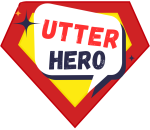
Speech & Language Tips for Parents
G Words in Speech Therapy – G Word Lists, Activities & Teaching Tips
When you’re working on helping your child with their speech and articulation, it’s essential to focus on specific sounds to improve their skills. One of the critical sounds in speech therapy is the G sound. G words can be found in various positions within words: initial, medial, and final. Each position may require slightly different strategies in speech therapy. To address an articulation disorder, speech-language pathologists often use a variety of activities and tools, such as audio recordings, games, and books, to help clients practice the G sound in a fun and engaging way.
A good starting point for working on G words in speech therapy is identifying voice and voiceless pairs. These pairs can help you focus on the correct positioning and airflow needed for accurate G sound production. For example, the voiceless pair for the G sound is the K sound. By practicing words containing both G and K sounds, you can better understand the differences between them and improve your articulation.
Articulation activities play a crucial role in the development of the G sound. Speech-language pathologists often provide clients with word lists containing initial, medial, and final G words. These lists can serve as a foundation for various activities such as flashcards, sentence building, and reading passages. Client-specific activities can also be developed, keeping in mind their interests and preferences.
Constant practice is essential for improving articulation and mastering the G sound. As a client or a speech-language pathologist, incorporating G words into daily routines and communication can be highly beneficial. Encourage conversation, storytelling, and reading materials that focus on G words to reinforce practice and enhance overall progress.
Remember, working on G words in speech therapy is a dynamic and gradual process. As you continue to practice and engage in articulation activities, you’ll notice improvements in your speech and articulation abilities over time. Always approach the process with patience, persistence, and a friendly attitude to ensure success.
Importance of G Sound
Working on the G sound in speech therapy is essential as it helps improve your pronunciation and expands your vocabulary. This voiced sound is a common component in the English language and can be found in various words. Mastering the G sound can lead to a boost in confidence when speaking and communicating with others.
The G sound requires proper articulation, involving the use of your soft palate and vocal cords. When pronouncing the G sound, the back of your tongue should make contact with your soft palate , while your vocal cords vibrate simultaneously. It’s crucial to be mindful of these processes as they play a significant role in producing a clear and accurate G sound.
In addition to the G sound, it’s essential to differentiate it from the /k/ sound in speech therapy. Both the k and g sounds are produced in the same location in the mouth, but with a critical difference: the G sound is voiced, while the /k/ sound is voiceless. Being able to distinguish between these paired sounds can enhance your overall speech clarity and articulation skills.
There are also soft g sounds and hard g sounds. The rule to remember which is which, is as follows: When g meets a, o, or u, its sound is hard. When g meets e, i, or y, its sound is soft .
To sum up, incorporating G sound practice in your speech therapy sessions can greatly benefit your pronunciation, vocabulary, and articulation. Remember to pay close attention to the role of your soft palate and vocal cords, and be aware of the differences between the G sound and its voiceless counterpart, the /k/ sound. Keep up the good work, and your efforts will surely lead to improved speech proficiency.
Teaching Methods for G Words
When it comes to speech therapy, teaching the G sound can be quite an adventure. As a parent of a child who is having speech therapy or is waiting to receive it, there are numerous techniques you can employ to help children master this sound. The key to success is practicing often and incorporating a variety of strategies.
First and foremost, your resources are your best friends. Books, games, and picture cards all offer fantastic ways to engage young learners. A favorite activity among speech therapists is using G Word Lists and Activity Ideas . These lists include initial, medial, and final G word suggestions, along with appropriate games and book recommendations tailored to the G sound.
Since children tend to learn better through play, incorporating games into speech practise sessions at home can be a game-changer. Utilize age-appropriate games that involve the G sound, such as guessing games or picture card matching activities. You may also create your own G-themed games, such as a scavenger hunt where children must find objects that start with the G sound.
While working on the pronunciation of G words, provide your child with ample opportunities to observe their mouth movements. One useful tool for this purpose is a mirror. Encourage them to focus on their tongue placement and the way it feels when they correctly produce the G sound. By allowing children to see and feel the differences in their mouth, they can better understand the necessary actions to produce the G sound.
Flashcards are another excellent resource to use outside of speech therapy sessions. You can create or purchase sets of flashcards featuring G words at various positions within words (initial, medial, and final). These visual aids can help children associate the sound with its spelling and encourage them to practice the G sound in various contexts.
Remember, patience and encouragement are essential when helping children develop their speech skills. By utilizing these various teaching methods for G words in speech therapy, you’ll be well on your way to helping them master the G sound in a friendly and engaging manner.
Role of Word Lists in Therapy
When it comes to speech therapy, word lists play a crucial role in helping your child or yourself develop and practice correct pronunciation of specific sounds. Among these, G words are quite common in language and working on them can significantly improve your articulation skills. So, let’s delve into the benefits of using word lists and explore some essential G word categories.
One of the significant reasons to use word lists in therapy is their ability to provide a structured approach to practicing particular sounds. In the case of G words, there are different types of lists, such as initial G words , medial G words, and final G words . By breaking down the words into groups based on their positions, it becomes easier for you to focus on and master the specific sound within different contexts.
Another advantage of using word lists is their potential to incorporate common vocabularies or target words you’ll encounter regularly in daily communication. This makes your child’s practice more functional, ensuring that they’re not only working on improving sound pronunciation but also enhancing their overall language skills.
Articulation Practice with G Words
Friendly and consistent practice is essential in mastering speech sounds like the /g/ sound. As you begin your articulation practice, remember that the g sound is a back sound, produced when the back of the tongue touches the soft palate in the back of the mouth. To help you understand the right tongue placement, consider checking out some articulation worksheets .
When practicing G words, it’s crucial to have a variety of initial, medial, and final G words to work with. Start with simple words like gum, goat, and dog , progressing to more complex words and phrases as you become more comfortable with the sound. You can find comprehensive G word lists for speech therapy that cater to different speech requirements.
Incorporate various activities into your child’s practice to make it engaging and fun. For example, you could play games, read books focusing on G words , or even create a word treasure hunt challenge. Aim for a minimum of 100 trials in each practice session, focusing on functional words that you regularly use in your everyday conversations.
As you practice, it’s important to remain patient and maintain a positive, friendly attitude. Encourage yourself by celebrating small achievements along the way. Make sure to practice regularly and consistently to reinforce learning and improve your G word articulation in everyday speech.
Remember, mastering the G sound takes time, persistence, and dedication. Keep practicing, use various G words and activities, ensuring proper tongue placement and speech sound production. With consistent effort, you’ll notice improvements in your child’s G word articulation over time.
Specific G Words for Therapy
Incorporating a variety of G words into speech therapy sessions can help clients practice and improve their articulation of the G sound. In this section, you’ll find a selection of G words that may be used in various activities and games during therapy sessions. These words are organized based on their position within the word (initial, medial, or final) and also include compound words and multisyllabic examples.
Initial G Words
Medial G Words
Final G Words
Compound Words
Multisyllabic Words
Additional G Words
Combating Phonological Processes
Phonological processes are simplifications that young children use while learning to talk. They’re a normal part of language development but can become problematic if they persist beyond a certain age. Two common phonological processes we’ll discuss are fronting and context-sensitive voicing .
Fronting : Fronting occurs when a child replaces a sound that should be produced in the back of the mouth, like “g” (as in “goat”) or “k” (as in “cat”) with a sound produced in the front of the mouth, like “t” or “d.” To address fronting, try these strategies:
- Encourage your child to pay attention to the placement of their tongue when they say words with “g” or “k.”
- Use visual cues, such as a mirror, to help your child see where their tongue should be when producing these sounds.
- Practice with minimal pairs, which are pairs of words that differ by only one sound, such as “goat” and “toat” or “cat” and “tat.”
Context-sensitive voicing : This process involves replacing a voiceless sound with a voiced sound. For example, when “pig” is pronounced as “big” or “car” is pronounced as “gar.” To help your child work on context-sensitive voicing, consider these tips:
- Teach them the difference between voiced and voiceless sounds, and practice each sound in isolation.
- Focus on pairs of sounds that have the same place and manner of articulation but differ in voicing, such as /p/ and /b/ or /t/ and /d/.
- Use auditory and visual feedback methods, like listening to recordings of your child’s speech, to help them hear and see the difference between voiced and voiceless sounds.
Remember to be patient and supportive as your child works on these skills. With consistent practice and encouragement, you’ll see progress in combating phonological processes. Good luck!
Therapy Resources and Materials
As a speech therapist or a parent looking for G word resources , there are a variety of helpful materials available to support your speech therapy sessions. Here, we will explore some of the resources and tools that can enhance your therapy sessions and make them more engaging and effective.
To start, consider finding online resources with plenty of articulation activities to keep your sessions diverse, and keep your clients motivated. Websites like Speech and Language at Home or Speech Therapy Talk can be great starting points for finding G word lists and speech therapy activities.
As a member of various professional speech therapy websites and organizations, you can access additional resources, tips, and support from your peers. Make sure to take advantage of professional memberships that offer exclusive content and materials catered towards speech therapists.
Flashcards can be a very useful tool when practicing G words, as they allow the visual representation of the word, as well as the auditory component when spoken out loud. You can find 600+ G Words Lists for Speech Therapy Articulation or create your own set of flashcards, such as boom cards, tailored to your child’s needs.
For more hands-on activities, consider incorporating books into your therapy session that emphasize G words. Reading these books together can provide a fun and engaging way to practice G word pronunciation and improve overall articulation.
Picture cards are another effective way to work on G words in speech therapy. By providing a visual representation of the word, you can help clients associate sounds with their corresponding images. Try using resources like K and G Words, Lists, Materials, and Everything You Need! for picture cards and other helpful tools to supplement your speech therapy activities.
Remember to keep your tone friendly and adapt to the needs of your clients as you explore these resources and materials. Your dedication to enriching their therapy experience can go a long way in promoting progress in their speech and communication development.
By Michelle
Related post, consonant digraphs: what they are and how they work, what are underextension and overextension in linguistics, short oo words – examples & rule for the short oo sound, leave a reply cancel reply.
Your email address will not be published. Required fields are marked *
Save my name, email, and website in this browser for the next time I comment.
What is Echolalia? Understanding the Repetitive Speech Phenomenon
How many words by 18 months a guide to your toddler’s language development.

Free G initial words list and 40 flashcards
G initial words.
Here are a couple of initial G words lists, 40 free PDF flashcards, and some example sentences that can be used for pronunciation exercises. These resources can be used for articulation lessons with ESL learners and speech therapy for any speakers who have issues making the /g/ sound.
The printable Word list above features just over 100 words with the initial G sound. While the list below contains 200 words.
What are G initial words? They are simply words where the /g/ sound appears at the beginning of the word. If the sound occurs in the middle of a word it is known as the medial position. If it is at the end, it is in the final position.
G initial words list
This list of words with the initial G or /g/ sound is much more comprehensive than the PDF above. It has been organized in alphabetical order to make navigating it easier. You can use this list to create your own initial G word activities.
It should be noted that while the majority of this list contains the hard G sound there are also instances of soft G words , and even a few instances of a silent G.
G inital words flashcards
Next, we have some beautiful flashcards of G initial words with real photographs and words. All 40 flashcards use the hard G sound. These are great for playing games and make learning enjoyable.
You will also find that learners are much more interested in practicing this area of pronunciation when they are presented with these visual teaching aids.
The 40 words on these printables are –
Sheet 1 – galah, galaxy, gallop, garbage, garlic, gas, gate, and gator.
Sheet 2 – gecko, glass, glide, glow, goal, gonna, goat, and goggles.
Sheet 3 – gold, golf, gong, goose, gorge, gorilla, gourd, and gown.
Sheet 4 – grain, grape, grate, gravy, Greek, green, grid, and grill.
Sheet 5 – grin, grind, grow, guard, guava, guitar, gulf, and gum.
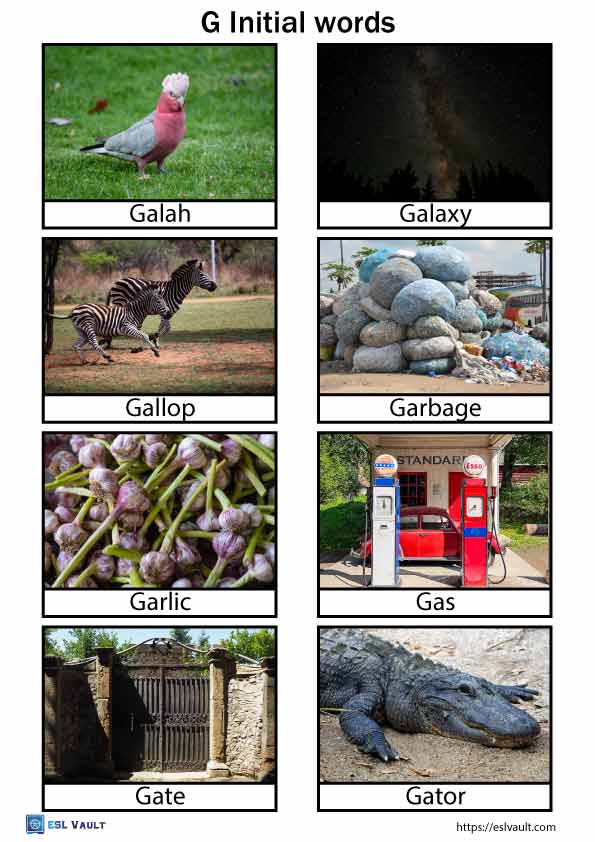
Practice sentences with G initial words
Try these simple yet fun sentences for learners looking to practice initial G words.
The girl is going to Ghana.
A gliding golden goose.
The gorilla grabbed the grapes.
A gecko in a guava garden.
Growing green Greek gourds.
She’s got grilled goose with garlic gravy.
Gary gave a goat a gift.
A glowing glass ghost.
Gazing at gaunt gazelles grazing gracefully.
Go and get the guitar gear.
Gabrielle got good grades.
Related activities
For some challenging initial G words practice, check out the letter G tongue twisters.
For some more flashcards, word lists, and pronunciation tips, try the G and D minimal pairs as well as the K and G minimal pairs .
You might also like these

Free long OO words list and 32 pictures (PDF)
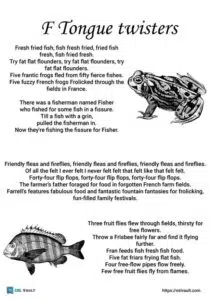
32 fun F tongue twisters

Fun rhyming words for kids
Free ESL and English teaching resources, no sign up required. Just find what you like, download it and head to class!
Privacy Policy
Share ESL Vault with your friends!
- Writing Worksheets
- Vocabulary Worksheets
- Pronunciation
- Kids worksheets
- Idioms and Expressions
- ESL Puzzles
- ESL Pair Work Activities
- ESL Conversation Questions
- Coloring Pages
- Articles, Lists and Ideas
- Art and Craft Activities

- Filterable Flashcards
- Print Flashcards
- Our Favorites
- Affiliate Notice
Free SLP Initial G Materials, Games, Activities, Flashcards, and more!
Initial g virtual games and activities, freeslp offers tons of virtual slp materials for the s sound. to help target the g sound in the initial, medial, and final positions, we have created g tic-tac-toe, connect 4, virtual flashcards, virtual progression cards, battleship, spot-it, candy land, soccer, painting, and more to view our all free g sound virtual games and materials, click below:, initial g sound games and activities link.
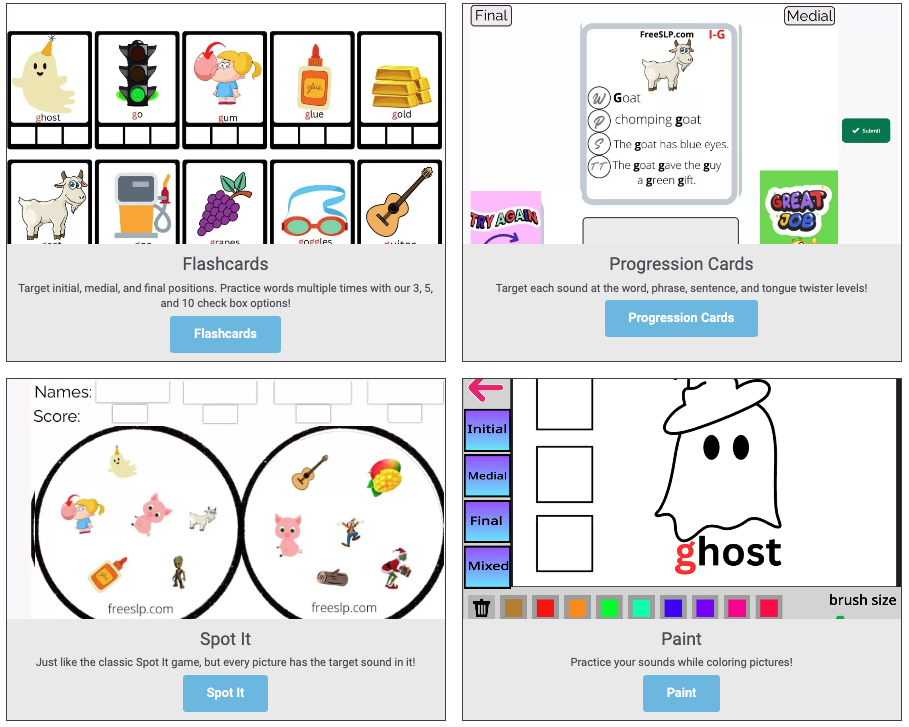
Downloadable Initial G Materials
We also have tons of free no-prep downloadable g sound materials. g sound printables that we currently have include: g flashcards, qr code scavenger hunt, progression cards, spot-it, word finds, tic-tac-toe, bingo, candy land, connect 4, battleship and more if you're looking for more engaging ways to teach the g sound, hopefully you find these materials helpful to view our all free g sound virtual games and materials, click below:, initial g no-prep downloadables.
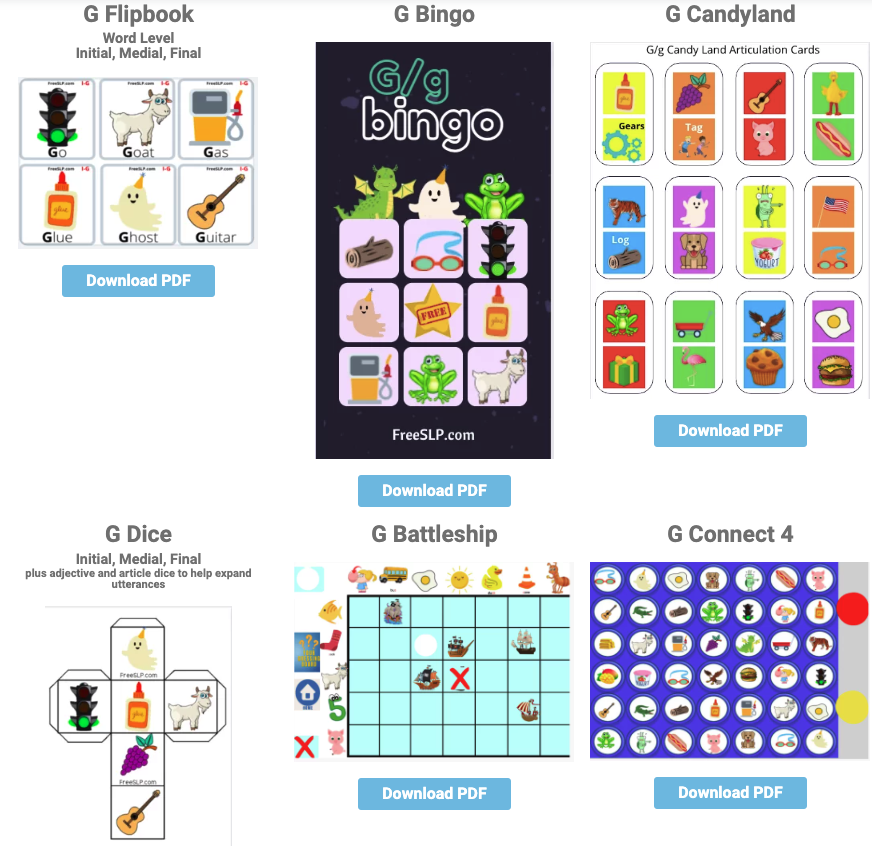
Initial G Sound Animated Videos
Animated videos for each sound teaching how to produce the sound as well as animated articulation adventures for each sound adventure across safaris, space, the world of minecraft, and more while teaching your child how to make awesome g sounds to view our all free g animated videos, click the link below:.
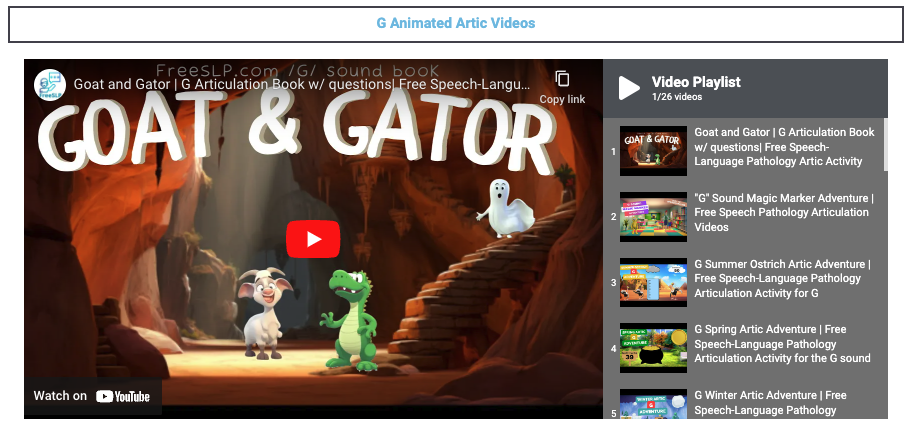
Initial G Artic Hierarchy Activities
Virtual materials to target g from the isolation level all the way up to the conversational level whether you're targeting sounds at the word, phrase, sentence, paragraph, story, or conversational levels, we have free and engaging speech therapy materials for each to view our all free g hierarchy activities, click below:.
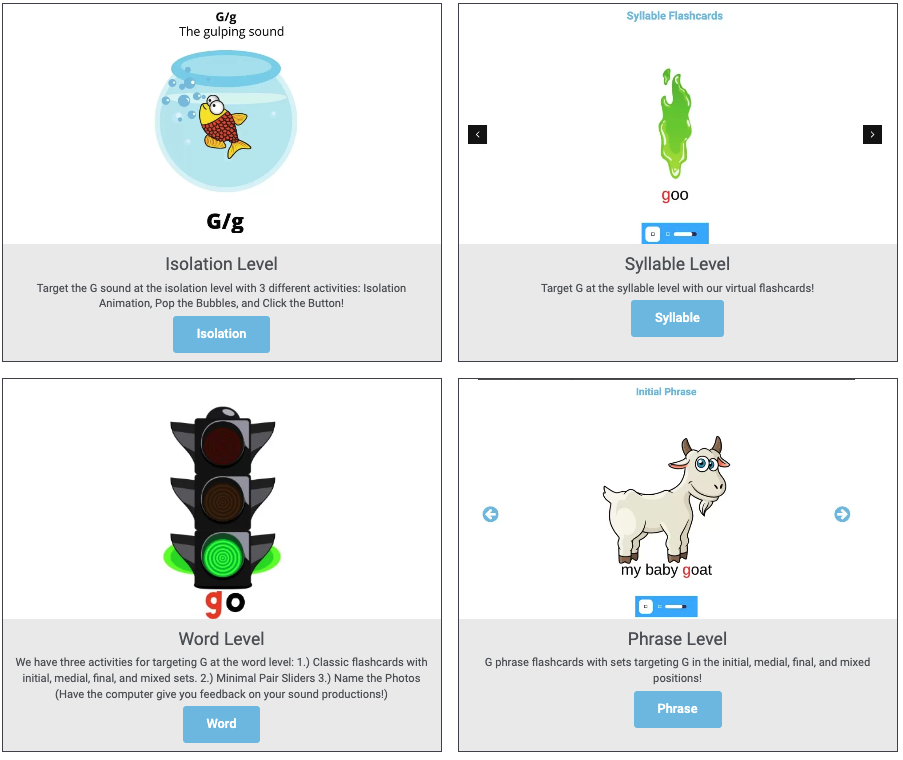
Initial G Filterable Flashcards
Over 1,000+ flashcards that you can sort by target sound, position of sound, syllables, blends, and more add words to your custom word list and print out the flashcards to view our all free g sound virtual games and materials, click below:, initial g filterable flashcards.
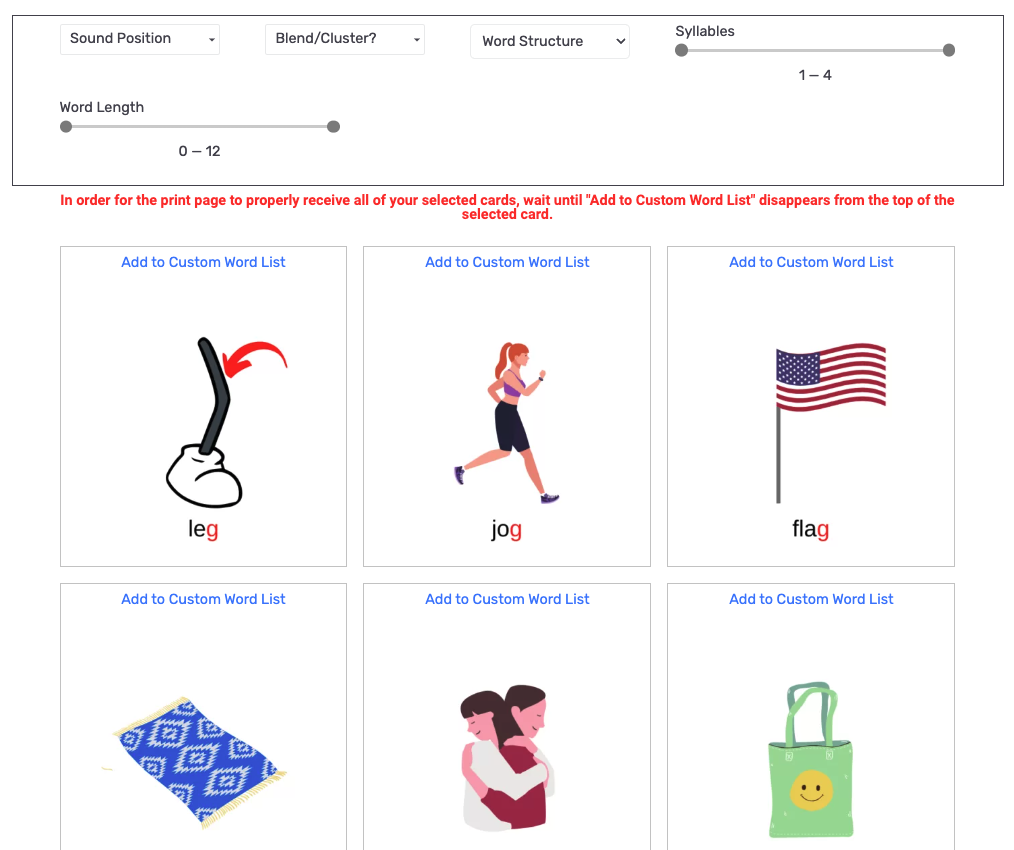
Initial G sound overview page
What age should my kid be able to say the g sound.
Children typically are able to correctly produce the G sound around 3 years old.
Is the G sound a voiced sound?
Yes, the G sound is a voiced sound?
Is the G sound a Dorsal Velar sound?
Yes, the G sound is a dorsal velar sound.
Is the G sound a stop?
Yes, the G sound is a stop.
What is the difference between C / K and G?
The C / K and G sound are produced exactly the same with one exception. The difference between C / K and G is that the C / K sound is voiceless and the G sound is a voiced sound.
50 Initial G Words
40 medial g words.
- Magnificent
35 Final G Words
How do i make the g sound, how to make the “g” sound:.
- Tell the child to bring the back of their tongue(called the dorsum) up to the back part of the mouth(called the soft palate). Lifting up the back part of our tongue stops the airflow from coming out of our mouths!
- Turn on your voice ( voice is the rumbling in your vocal folds. Have your child/client place their hand on their/your neck during the production of “c/k” and “g”, and have them feel the difference between the two. In the production of “c/k”, there should be no rumble or voicing. While in the production of “g”, there should be a rumbling or voicing.)
- Next we lower our tongue and push air out explosively at the same time!
Tricks and Tips for producing the “g” sound:
- Tell the child we are going to trap the air from escaping using the back of our tongue. We need to make a hump or a hill using the back of our tongue and bring it to the roof of our mouth.
- A fun and tasty way to teach the child where to put their tongue for a “g” production is to put some Nutella, peanut butter, sour candy gel, or any other spreadable food they enjoy on the soft middle portion of the back of the mouth(soft palate). Once the child has felt the spot a few times, have them try to blow out air while lowering the tongue at the same time!
- If your child is replacing their “g” sounds with “d” sounds. (“dod” for dog”), try using a tongue depressor to hold down the tip of their tongue which should also help the back of their tongue bunch up.
- Place your hand where the child’s jaw and neck meet, and during “g” productions, lightly push up to help remind them to raise the back of their tongue.
- To visually show the child how we explosively release air from our mouths to produce the “g” sound, hold a piece of string in front of their mouths, and have them try to move the string with the release of air. It is important to remind them to remember to use their voicing during this activity!
- If you have a board game that uses a spinner, have the child see if they can move the spinner using the explosions of air from their mouths.
- Have the child tilt their head back and look up at the ceiling. By doing so, our tongues tend to fall into the back of our mouths into the position we need to make the “g” sounds
- Challenge the child to an imaginary water/juice/milk drinking contest. See you can making the “g” gulping noise the most times in 10 or 30 seconds!
G Sound Overview
If you are looking for tips and tricks on how to produce the perfect G sounds; click the link below:
Virtual Materials for Each Level of Artic Practice:
Target the G sound at the isolation level with 3 different activities: Isolation Animation, Pop the Bubbles, and Click the Button!
Target G at the syllable level with our virtual flashcards!
We have three activities for targeting G at the word level: 1.) Classic flashcards with initial, medial, final, and mixed sets. 2.) Minimal Pair Sliders 3.) Name the Photos (Have the computer give you feedback on your sound productions!)
G phrase flashcards with sets targeting G in the initial, medial, final, and mixed positions!
Target G at the sentence level with our rotating sentences activity!
Our G story is full of G target sounds and tongue twisters! Read it yourself or play it out loud and then repeat it back!
We have two ways to target G at the conversation level: 1.) Silly story scenes full of G target words. 2.) Conversation starter questions.
G Virtual Materials
List of All the Free G Sound Virtual Activities and Games
G flashcards, g progression cards, g soccer shootout, g escape from dragon's dungeon, g fish's flight to freedom, g witch's brew, g summer sundae dash, g fall apple quest, g halloween candy chompers, g thanksgiving treats, g cupid's valentines candies, g marshmallows' mad dash, g unicorn artic derby, g train track dash, g space race, g flashlight finder, g feed the bear, g pumpkin carving, g build-a-snowman, g thanksgiving dinner, g tic-tac-toe, g candy land, g connect 4, g battleship, g artic ninja, g volt runner, g artic clicker, g pizza jumper, g artic cruiser, g space invaders, g spot the differences, g treasure hunt, g crossword, g word find 1, g word find 2.
G Boom Cards
List of All the Free G Sound Downloadable and Printable and Games
G artic qr scavenger hunt, g artic progression cards, g artic spot the match, initial artic g flashcards, medial artic g flashcard, final artic g flashcards, g articulation carrier phrases, g articulation word find, g articulationtic-tac-toe, g articulation coloring sheet, g cartoon character flashcards, g articulation dice, g articulation flipbook, g artic bingo, g artic candyland, g artic cariboo cards, g artic battleship, g articulation connect 4.
G Printables
Free no-prep, virtual, and downloadable options available!
Free SLP articulation word lists, flashcards with pictures, downloadable PDFs and more!
Materials target the G sound in the initial, medial, and final positions!
Whether you are looking for printable, no-prep, or virtual materials, FreeSLP offers free G sound activities for students of every level!
We hope these G articulation activities and exercises for speech therapy help your child / student learn how to make s sounds!
Privacy Overview

How to Teach K Sound: Articulation Activities, and Word Lists for Effective Speech Therapy
How to teach ng sound: articulation activities, and word lists for effective speech therapy, how to teach g sound: articulation activities, and word lists for effective speech therapy.
The “g” sound is a voiced velar plosive, which means that it is produced by briefly stopping the airflow from the lungs using the back of the tongue (velar) and then releasing it in a sudden burst (plosive). The vocal cords vibrate during the production of this sound, which creates a buzzing or humming sensation in the throat.
To produce the “g” sound, you need to raise the back of your tongue towards the soft palate or velum, which is located at the back of your mouth, and then release it while simultaneously pushing air out of your lungs. This creates a sudden burst of sound that is characterized by a low-pitched, vibrating noise. You can try producing this sound by saying the word “go” or “get” and paying attention to the way your tongue and vocal cords work together to create the sound. In phonetics, this sound is represented by the symbol /g/. It is also sometimes referred to as the “voiced velar plosive.”
Here are few tips you can follow to teach the “g” sound:

Demonstrate the sound : Start by demonstrating the “G” sound for your child. Make the sound and have your child watch your lips and mouth movements. Explain that the sound is made by pressing the back of the tongue against the soft palate and releasing it with a voiced sound.
Visual Cue : Show the child how to place the back of their tongue against the soft palate at the back of their mouth, and then release the air with a voiced sound. You can use a mirror to help the child see how their tongue is positioned. You can also use a visual cue such as a picture or flashcard of a “G” to help your child remember the sound.
Understand the sound: Help your child understand that the “G” sound is a voiced consonant made by pressing the back of the tongue against the soft palate and releasing it with a voiced sound.
Practice Blowing: Help your child get used to the sensation of releasing air with their tongue by having them practice blowing out candles, blowing bubbles, or blowing feathers across a table.
Practice Tongue Placement: Show your child how to keep the back of their tongue flat and relaxed while making the “G” sound. You can make it more fun by having them imitate animal sounds, such as a growling dog or a grunting pig, while using the “G” sound.
Practice in Isolation : Once your child has mastered the correct tongue and mouth position, have them practice making the “G” sound on its own without any other sounds.
Add Syllables: After your child has mastered the “G” sound in isolation, have them practice using it in different syllables, such as “ga,” “ge,” and “go.” You can make it more fun by having them say words like “giraffe,” “gum,” and “goofy.”
Practice in Words: Once your child has mastered the “G” sound in syllables, have them practice using it in different words such as “girl,” “goat,” and “green.”
Practice in Phrases: After your child has mastered the “G” sound in words, have them practice using it in phrases like “big girl,” “my goat,” and “green grass.”
Practice in Sentences: Finally, have your child practice using the “G” sound in different sentences such as “I have a big girl bike,” “The goat ate the grass,” and “Green is my favorite color.”
Practice Everywhere: Encourage your child to practice using the “G” sound in different contexts, such as during playtime, mealtime, or while reading books. You can also make it more fun by having them use the “G” sound in different accents or dialects.


Your cart is currently empty.
Total: $0.00
G Word List
Activities you may like....

BUNDLE Executive Function
✨ As seen on Boom Cards Featured Bundles!
This BUNDLE of executive function cards includes problem solving stories, social stories, predicting stories, sequencing stories, and flexible thinking stories.
Multiple types of wh- questions, why and how questions, labeling exercises, multiple choice, and drag and drop categorizations are included throughout this bundle to encourage an in depth understanding of each executive functioning skill.
⭐️ 80 Problem Solving
- Multiple choice question
- 2 labeling exercises
⭐️ 52 Social Stories
- Topics of social skills to choose from (feelings, manners, listening, sharing & turns, making friends, being kind)
- Sorting exercise
- 2 wh- questions
⭐️ 50 Predicting (✨ as seen on Top Premium Boom Cards ✨)
- What questions
- How questions
⭐️ 50 Sequencing
- 3 different what questions per story
⭐️ 40 Flexible Thinking (✨ as seen on Top Premium Boom Cards ✨)
- Why questions
- Labeling exercise
Each deck includes a teaching slide and visual to help your students better understand executive function skills before practicing!
CLICK HERE for Boom Cards Preview.
To use Boom Cards, you must be connected to the Internet. Boom Cards play on modern browsers (Chrome, Safari, Firefox, and Edge). Apps are available for modern Android, iPads, iPhones, and Kindle Fires. For security and privacy, adults must have a Boom Learning account to use and assign Boom Cards. You will be able to assign the Boom Cards you are buying with "Fast Pins," (a form of play that gives instant feedback to students for self-grading Boom Cards). For assignment options that report student progress back to you, you will need to purchase a premium account.If you are new to Boom Learning, you will be offered a free trial of our premium account.Read here for details: http://bit.ly/BoomTrial .

Wh- Questions & Short Stories
15 short stories to target wh- questions, auditory comprehension, reading comprehension, recall, and more!
Multiple levels of difficulty, including both shorter and longer paragraphs for a variety of length and detail in the stories.
✨ As featured on Boom Cards Top Premium Decks ✨
⭐ Wh- Questions in Short Stories
- 15 Paragraph Short Stories
- 6 Wh- Questions for every story
- Stories are 4-9 sentences in length
- What, where, who, when, why, and how questions for every story
BUNDLE for Wh- Questions also available in Shine Speech Activities shop , which includes short stories and sentences!
CLICK HERE for Boom Cards Preview .
*This product contains the same activities as the PDF version. If you would like the PDF version, view Wh- Questions & Short Stories, Auditory Comprehension .
To use Boom Cards, you must be connected to the Internet. Boom Cards play on modern browsers (Chrome, Safari, Firefox, and Edge). Apps are available for modern Android, iPads, iPhones, and Kindle Fires. For security and privacy, adults must have a Boom Learning account to use and assign Boom Cards. You will be able to assign the Boom Cards you are buying with "Fast Pins," (a form of play that gives instant feedback to students for self-grading Boom Cards). For assignment options that report student progress back to you, you will need to purchase a premium account. If you are new to Boom Learning, you will be offered a free trial of our premium account. Read here for details: http://bit.ly/BoomTrial .

Sentence Comprehension & Language Comprehension
Improve sentence comprehension, language and reading comprehension, and picture comprehension with 4 activities and over 125 prompts for speech therapy or classrooms! Target comprehending, receptive language, and more.
This resource includes 4 different ways to practice sentence comprehension , including wh questions, pictures, fill in the blanks, and more. Real photos are included in this resource.
⭐️ Sentence Comprehension:
- 40 sentence comprehension task cards with 3 questions each
- 30 real photo sentence comprehension prompts
- 30 multiple choice reading comprehension activities
- 30 fill in the blank language comprehension prompts
⭐️ Targeted Skills:
- Improve sentence comprehension skills
- Increase receptive and expressive language abilities
- Expand skills for understanding sentences and pictures

Story Builders & Create A Story
Improve creative writing with these narrative and short story prompts! This set of 70 short story builders comes with character, location, event and time learning targets.
Help your students improve their stories and increase their creative narrative skills. There is space for students to type or write their stories, as well as an organizing task for story parts.
Your students will have all the tools they need to create unique and imaginative stories!
⭐️ Includes:
- 70 story builders
- 3 practice levels
- A combination of who (character), where (location), what (event) and when (time) story part targets
- 36 story builders that include 2 story parts
- 20 story builders that include 3 story parts
- 14 story builders that include 4 story parts
- Story parts organizing task with pictures
- Space for creative writing and narrative generation
- Instructions on each page
⭐️ Teaching slides:
- In depth information about the 4 included story parts
- Descriptions
- Picture matching activities
Save your time and energy, this set is NO PREP! Includes everything you need to elicit creative, engaging stories from your students.
Perfect for SLPs, teachers, or parents looking to expand language or writing in a fun and creative way!
Made with love in Austin, Texas
© 2020 Shine Speech Activities
Product Added To Your Cart
There are 0 Items In Your Cart
Total Price: $0.00
Compare Product
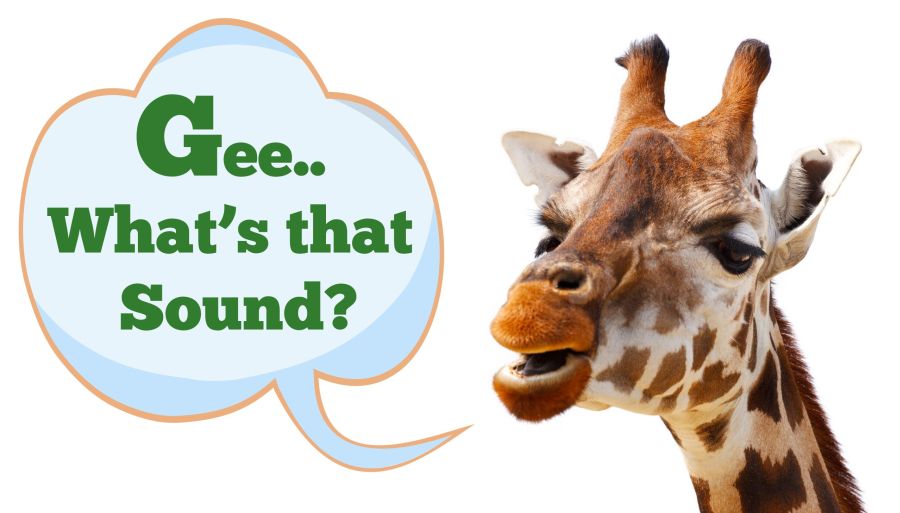
Teaching the Sound of Letter G
Teaching the Sound of G. Image courtesy of www.pronuncian.com
“Dess what Mommy?” “Where is the dod?, “When are we donna be there?” Are these familiar questions around your house? Is your son or daughter making a “d” sound in place of a “g”? Or, leaving the “g” sound out all together? If so, don’t fret. Most children under the age of five have some trouble correctly pronouncing certain sounds and words. While most children will usually mispronounce words at some point in her growth, the majority of children outgrow these mispronunciations and master correct sounds by certain ages. And, to make things even more complicated for your young child, there are two distinct sounds of “g” that he or she must perfect: a hard g and a soft g. Is there a way to help guide your child? YES! Here are some tips and tricks for teaching your child the sound of letter g.
Rules for Teaching the Sound of The Letter G
There are rules determining whether or not the sound of letter “g” is hard as in “good”, or a soft sound as in “giant”. The most common rule to remember how to pronounce the sound of the letter “g” is to pay attention to the letter following the “g” in that particular word. However, like many other rules in the English language, there are exceptions. Here are a few key rules:
- Hard g before a consonant (as in g lad or g reat)
- Hard g before a back vowel ( g o, g arden, g um)
- Hard g at the end of a word (bi g , fro g , le g )
- Hard g if it’s a Hebrew name ( G ideon, G iliad)
- Hard g before a front vowel in most words of Germanic origin ( g ift, g et, g ild)
- Soft g for a word of Greek origin that starts with gy- ( gy mnasium, gy mnastics, gy roscope).
- Soft g before a front vowel if the word has a Romance origin ( g eography, g iant, g inger, g eneral)
As we mentioned, there are always exceptions. Can you think of words that include both a hard “g” sound and a soft “g” sound? How about the words language, or garage! The sound of “g” is also called a “ voiced sound ” — one in which the vocal chords vibrate. Rachel’s English does a great job demonstrating how to correctly pronounce the sound of the letter “g”.
When Can I Expect My Child to Perfect the Sound of G?
The short answer is usually around the age of three. The longer answer is it depends. There are certain speech development milestones that your child is expected to meet, according to his or her age. Our friends at Mommy Speech Therapy have a terrific graphic that spells out speech milestone expectations. This Speech Sound Development Chart from Goldman Fristoe outlines what age your child should be expected to perfect each sound in the English language.
Speech Sound Development Chart by Goldman Fristoe. Image courtesy of Mommy Speech Therapy
It is during the first 3 years of life, when your child’s brain is developing and maturing, that is really the most intensive period for acquiring speech and language skills. All children vary in their development of speech and language skills. The milestone checklist serves as a guide to determine the normal development of speech and language skills birth to age 5. Of course, the rate of development is different in every child, as some may hit these benchmarks early, or some may be later than the norm. Don’t be alarmed if your child is not achieving these milestones exactly as they are presented on the chart. Instead, these guidelines are there to help doctors and other health professionals determine if your child is on track or if he or she may need extra help. Sometimes a speech delay or articulation disorder may be caused by hearing loss, while other times it may be due to a speech or language disorder.
Go On, Get Practicing!
One tip that may be useful is to have your child practice gargling water. When you gargle water, your tongue is in the same correct position as it needs to be to correctly pronounce the sound of the letter “g”. Give it a try! Also, don’t forget that you are your child’s best role model. Practice saying the “g” sound around the house in conversation, read books together and emphasize that sound (both the soft and hard sounds). Soon enough, your child will be “giddy” that he can make the perfect sound of “g”.

- Clipart Credits
- Privacy Policy

Fun G Words Speech Therapy Printable Game Free
Looking for a fun way to engage kids in speech therapy using games? This G Words Speech Therapy for initial sounds printable game with dot markers is perfect!
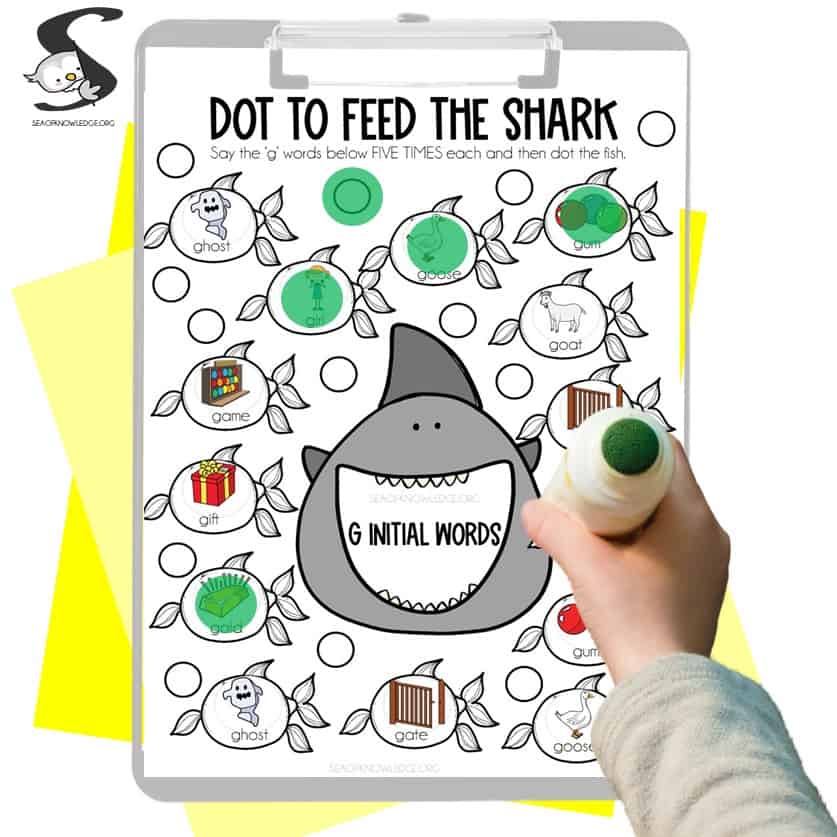
Looking for a great way to practice target words in g initial sounds?
Speech-language pathologists are always on the lookout for new and fun ways to help practice speech therapy in a fun way!
This printable game targets the g sound and encourages children to produce correct production of sounds.
G Sound Word Lists
The list used in this game are simple words that begin with the initial g sound. the sound is produced in the soft palate which sometimes is difficult for kids to learn.
Also, since it is produced at the back of the tongue, it can seem more difficult to master.
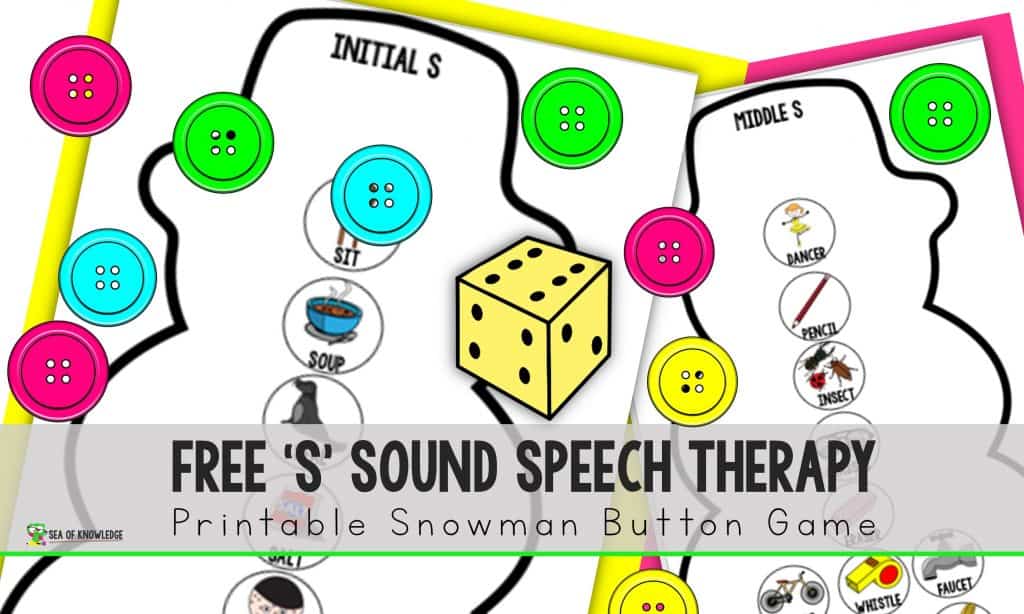
Snowman themed s sound speech therapy snowman game.
Speech sounds can be practiced using simple calling card, however using games like this one will make for a great way for young children to practice the initial position sound in any speech session.
G Sound in Speech Therapy
The “g” sound is a voiced velar fricative. Also, the “g” sound is made by first pressing the back of the tongue against the velum, or soft palate, and then moving it forward to touch the upper teeth.
A g sound can be used at the beginning of a word to represent an action that will happen in the future. For example, “I’m going to go get gas.”
How to practice letter sounds in speech therapy
Practicing letter sounds is an important part of speech therapy. Children who are learning to read should be able to recognize the different sounds that letters make.
This article will show you how to practice letter sounds in speech therapy, and what you should do if your child is struggling with a certain letter sound.
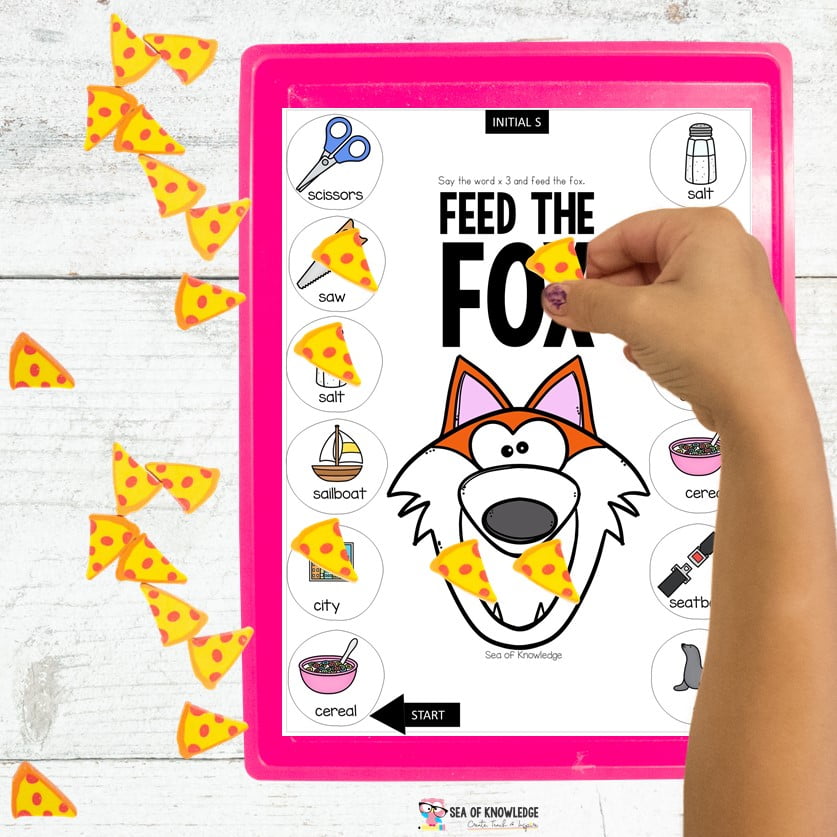
Don’t forget to get these free printable fox themed games for ‘s’ sounds in all positions!
For each sound, there are three activities that can be done:
-Pretend that you’re a cat and say the sound as meow.
-Say the sound while pretending to brush your teeth or eat breakfast.
-Say the sound while pretending to count from 1 to 10.
Children can use the back of their tongue to practice pronouncing the g sound initial words.
Sometimes, kids just need a little more practice and doesn’t always mean that they have an articulation disorder. Sometimes, practising sound sin front of a mirror helps!
Picture Cards for Child’s Speech
I always try to use picture cards for speech articulation, but games work just as well if not better.
Video game or games like Boom Cards would also work perfectly to help kids master correct position of sounds in words; and help practice proper vocal cords.
This game would do a great job at working on g words speech therapy. If you’re looking for more games like this, be sure to sign up to see medial and final g sounds released soon on this blog.
If you’re a speech therapist who is constantly looking for new and fun ways to practice a single sound at word or sentence level with your learners or patients, you’ve come to the right place!
G Words Speech Therapy PDF Game
Download your FREE set below. Please note however that:
- This is for personal and personal classroom use (to share this resource, please direct others to this post to grab their own free copy)
- This may NOT be sold, hosted, reproduced, or stored on any other site (including blog, Facebook, Dropbox, etc.)
- All materials provided are copyright protected. Please see Terms of Use .
- Graphics Purchased and used with permission
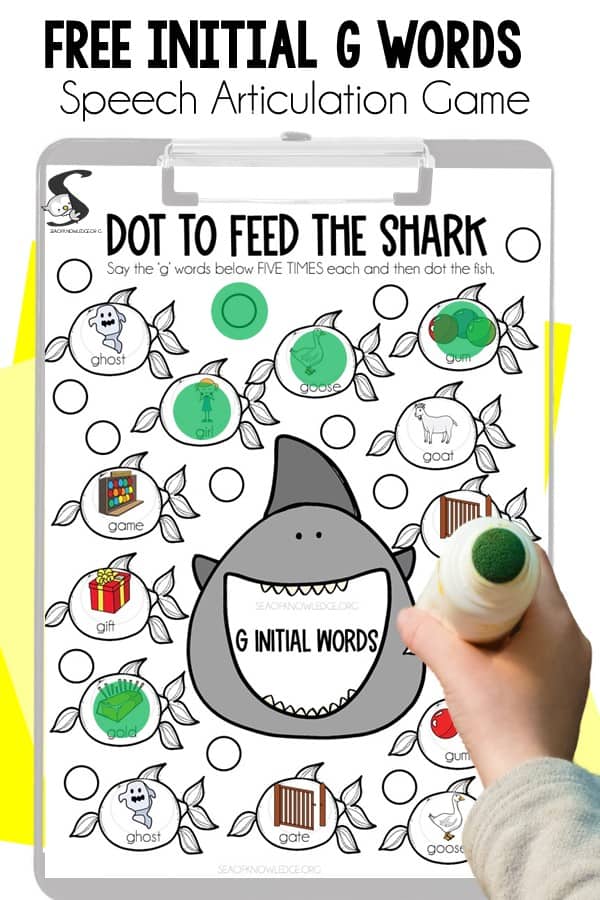
G Words Speech Therapy Shark Game
Input your email to get a direct link to this printable pack!
You may also like
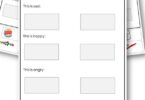
10+ Free Life Skills Worksheets – Printable...
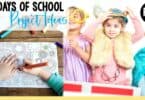
Ideas for the 100th Day of School [100 days of school...
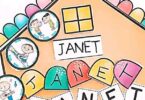
Gingerbread Man Template Craft: Building Social Skills...
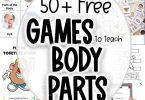
50+ Body Parts Games for Preschoolers: Download Over...
Leave a comment x.
This site uses Akismet to reduce spam. Learn how your comment data is processed .
Any call to action with a link here?

The BEST K and G Words (Speech Therapy)
If you’re a speech language pathologist looking for activities, ideas, and articulation word lists for k and g words speech therapy practice, then you’re in the right place! This blog post explains the correct tongue position for k and g sounds. In addition, this article lists the most common substitutions for k and g, as well as articulation therapy tips for eliciting k and g sounds. Read on for k and g words speech therapy lists, and make sure to check out the recommended articulation activities for practicing these sounds!

This post contains affiliate links, which means we could receive a commission if you click a link and purchase something that we have recommended.
Why Does a Speech Therapist Target K and G Words (Speech Therapy)?
A speech-language pathologist often targets k and g words in speech therapy.
Many children, especially young children, have a hard time correctly producing k & g.
SLPs teach the correct placement for velars and practice the target sound (k,g) in words, short phrases, and at the sentence level.
It is important to target a variety of articulation sounds as children with speech sound disorders may be at risk for reading disorders .
Reference:
Sices, L., Taylor, H. G., Freebairn, L., Hansen, A., & Lewis, B. (2007). Relationship between speech-sound disorders and early literacy skills in preschool-age children: impact of comorbid language impairment. Retrieved from https://www.ncbi.nlm.nih.gov/pmc/articles/PMC2755217/#:~:text=Disorders%20of%20articulation%20or%20speech,phonologic%2C%20and%20verbal%20memory%20skills.

Correct Position for K and G
Both k and g sounds are velars and stops.
These velar consonants are both considered to be a “back sound”- or speech sounds made “in the back of the mouth”.
The correct tongue placement for both k and g involves the back of the tongue lifting to make contact with the soft palate.
At the same time, the front part of the tongue (tongue tip) is placed behind the lower front teeth.
A seal is formed for velar sounds and air pressure builds.
This is a quick movement. You will hear the velar sound with the burst of air that is released.
To feel this, put your hand near the front of the mouth during k and g production.
K is a voiceless sound. That means the vocal folds do not vibrate during the production of /k/.
G is a voiced sound. This means the vocal cords vibrate when saying /g/.
Have your student feel their throat while producing /k/ and then /g/ to feel the difference between voiced and voiceless sounds.
Reference: Peña-Brooks Adriana, and M. N. Hegde. Articulation and Phonological Disorders: Assessment and Treatment Resource Manual , PRO-ED, Austin, TX, 2007.
The Most Common Substitutions for K and G
Many different types of speech sound disorders can impact a child’s speech intelligibility.
This is an umbrella term that can include articulation disorders, phonological disorders, and motor speech disorders (such as childhood apraxia of speech ).
Phonological processes, including velar fronting or final consonant deletion , can impact the correct production of k and g sounds.
Need a breakdown of speech pattern simplifcations? Read about the different phonological processes .
Articulation Therapy Tips
Need a great way to teach the k&g sounds?
There are different ways to elicit these sounds during direct instruction therapy tasks.
- Try auditory bombardment. Read word lists or children’s books that contain k and g sounds.
- You could try instructing a child to “Lift the back of your tongue”- but I like to focus on the tongue tip as a better visual cue . I instruct my students to say their “low T” sound- and have the tip of their tongue touch the gumline behind their front bottom lower teeth.
- Minimal pairs can be very effective when targeting velar sounds.
- Use your hand as a visual for correct tongue placement.
- Use gravity! Have your student lay on their back while practicing these sounds.
- A certified SLP could try using a tongue depressor to assist with lingual placement. This would only be recommended for a child who is comfortable with this method.
- Working with younger students? I love doing “feed the….” activities, which would be appropriate in early intervention or with preschoolers. Check out this crocodile hand puppet that can be fed small objects. Work on target words like “ick” and “yuck”.

Resource Pictured: Speech Sound Mouth Cards
Home Practice Ideas
Parents can help students work on the k and g sounds at home.
One idea might be to provide parents with an auditory bombardment word list .
Parents could read k or g words.
Their child should listen but not repeat the words.
Once a student can say the k or g sounds in isolation, they might practice simple CV or VC sound combinations (such as “go” or “ick”).
Finally, going on a scavenger hunt around the house for k and g words can be a fun activity.
Here are /k/ words that a child might find around the house:
G Word List
Are you looking for an articulation word list that contains g in the initial, medial, and final position of words?
This blog post contains g articulation word lists that can be used during your speech therapy session.
K Word List
Here is a word list for initial k, medial k, and final k words that speech pathologists can use in therapy.
These speech words can be paired with a game or a fun activity.
Articulation Word Lists
Do you need more articulation word lists to use in your speech therapy sessions?
Check out these handy lists:
- Multisyllabic Words (1-5 syllables)
- Cluster Words (S Blends)
- S Word Lists
- L Word Lists
- F Word Lists
- K Word Lists
- TH Word Lists
- R Words for Speech Therapy
- Z Word Lists
- V Words for Speech Therapy
- G Words for Speech Therapy
- SH Words for Speech Therapy
K & G Words Speech Therapy Activities
Are you a speech therapist searching for a fun way to practice target words in speech therapy?
If you are working on k and g sound production, be sure to check out these engaging resources.
- Speech Sound Mouth Visuals
These speech sound word cards will be unlike any you’ve ever owned.
You will be able to target a variety of speech sounds in the initial position, middle position, and end of a word.
First, these are a practical type of speech room decor – I hang them up on my wall!
Next, these articulation cards are in the shapes of mouths- so you’ll have the ultimate handy visual during articulation therapy.
Finally, these cards can be laminated for unlimited use.

Try these speech sound mouth cards to work on speech sounds at the word level.
Minimal Pairs Activity Play Dough Smash Mat
If you are working on fronting, these minimal pair activity sheets will be perfect to pair with play dough or a magnetic wand and chips!
This Minimal Pairs Bundle includes minimal pair pages for a variety of phonological processes, including:
- cluster reduction
- initial consonant deletion
- final consonant deletion
- voicing and devoicing

The velar and palatal fronting packet is included in the bundle.
How To Use The Minimal Pair Pages
An auditory bombardment word list is included on every page.
For example, if you are targeting the initial k sound, a list of initial k words is provided at the bottom of the page.
Your student would listen as you read the words, but not repeat them .
Next, you can do an auditory discrimination activity with your students. Which sound did they hear? I have my student give a thumbs up or a thumbs down to indicate if they heard (or did not hear) their target speech sound.
Finally, your student can practice minimal pairs .
If you are working on velar fronting, you’ll choose a specific page with either k or g words.
Magical Minimal Pair Worksheets and Activity Pages
This Magical-Themed Minimal Pair Bundle also targets fronting!
Every phonology activity contains both a color and low ink option, so it’s perfect for on-the-go. Just print!
If you wish, you can laminate the color pages.
In addition, this packet is FUN!
Let imaginations SOAR with this magical packet!
Adorable wizards, gnomes, fairies, and dragons decorate every page.

This Magical-Themed Phonology Bundle includes cluster reduction, voicing and devoicing, initial consonant deletion, final consonant deletion, fronting, and backing activities.
The fronting activity packet (which is included in the bundle ) contains the following minimal pairs:
- k vs t initial
- k vs t final
- d vs g initial
- d vs g final
- sh vs s initial
- sh vs s final
This will also you to target both velar and palatal fronting.
Articulation Tic-Tac-Toe Worksheets
Have some dot markers on hand?
Or perhaps a magnetic wand and chips ?
Perfect, because you’ll want to use them with this Articulation Tic Tac Toe resource!
A variety of speech sounds are targeted, including k and g.

Each page features words with one target sound in the initial position, medial position, and final position.
Your student will practice saying a word before each turn at the game.
If desired, your student could also generate short sentences using the target word!
K & G Mixed Groups Resource
School speech-language pathologists are often trying to see a large caseload while working around 15 or more teacher schedules, special schedules, and activity schedules.
This is in addition to fitting in IEP meetings and paperwork!
It can be a tough balancing act!
This often leads to seeing students in groups- and sometimes, the goals don’t always match up.

One student might be working on articulation, and another might have expressive or receptive language goals !
This Mixed Groups Bundle for Speech Therapy offers the solution.
One page is selected based on the target speech sound (such as the initial k sound, which is provided in the K & G Mixed Group Resource ).
Articulation words are sorted by noun or verb.
While one student works on articulation, another student can work on language goals- using the same target words.
In summary, this article provided a variety of k and g words speech therapy lists (see k words and g words ).
In addition, this article explained why a speech-language pathologist might target k and g words in speech therapy.
Read the article to better understand the correct lingual positioning for k & g.
Several elicitation tips are recommended for teaching velar sounds.
Related Speech Therapy Articles:
Try These Beneficial Fronting Activities for Speech Therapy
- The Different Phonological Processes (List for SLPs)
- 6 Quick (and Easy) Speech Therapy Activities for Preschoolers
Children’s Books for Speech Therapy: The Ultimate List
Finally, here are some effective resources to target k and g words in speech therapy:
- Minimal Pairs Activity Pages for Play Dough
- Magical-Themed Minimal Pairs Pages
- Articulation Tic Tac Toe Worksheets
- Mixed Groups Speech and Language Bundle for Speech Therapy
Similar Posts
If you are a speech language pathologist working with children who have articulation disorders or phonological disorders, chances are you’re always on the lookout for engaging fronting speech therapy activities! Keep reading, because this article provides suggestions for velar fronting and palatal fronting activities, as well as some tips and tricks to try out during…
6 Engaging (and Simple) Articulation Games for Speech Therapy
If you are a speech-language pathologist looking for the best articulation games for speech therapy, check out this helpful blog post! There are activities and games that speech therapists can use to target a variety of articulation skills. Additionally, articulation word lists are included, as well as suggestions for apps and websites that may be…
Z Words for Speech Therapy (Word Lists and Activities)
Need z words speech therapy lists? If you’re a speech-language pathologist looking for a quick list of initial z words and final z target words to practice during speech therapy, make sure to bookmark this post. You’ll also find some great ideas for making therapy more fun with a variety of engaging games, resources, and…

The Best WH Questions Speech Therapy Activities and Ideas
Speech-language pathologists often teach wh- questions in speech therapy sessions. There are different types of wh questions. WH questions contain the wh question words: Who, What, Where, When, Why, and How. A qualified speech-language pathologist may target wh questions in therapy to support language development. The ability to answer wh questions is very important for…
If you are a speech-language pathologist searching for the best children’s books for speech therapy, check out this blog post! Using books during speech therapy sessions provide a fun way to target articulation and language goals. This article explains why SLPs might use children’s books in speech therapy. Additionally, it provides suggestions for how to…

3 Easy Final Consonant Deletion Activities for Speech Therapy
If you are a speech language pathologist working with children who have articulation disorders or phonological disorders, chances are you’re always on the lookout for engaging final consonant deletion speech therapy activities! Keep reading, because this article provides suggestions for final consonant deletion activities, as well as some tips and tricks to try out during…

50+ Best K and G Speech Therapy Activities (Free and Fun)
K and g speech therapy activities: effective techniques for articulation improvement.
If you are a speech therapist working on articulation therapy for the K & G sounds, then you are at the right place. In this blog post, we want to provide you with activities that specifically target the production of the ‘K’ and ‘G’ sounds. Articulation disorders and errors are common for these target sounds. These errors can affect a child’s speech, impacting their ability to communicate effectively.
A great way to address these specific sounds in your speech practice, is to use a variety of techniques and tools. From one speech therapist to another, I wanted to make your therapy sessions easier, so in this blog post we will review how to correctly produce these speech sounds, give you a list of over 50 fun activities to do to practice correct sound production of ‘K’ and ‘G’ in your therapy sessions, as well as provide you with a great ‘K’ and ‘G’ articulation bundle freebie to start practicing these target sounds today!
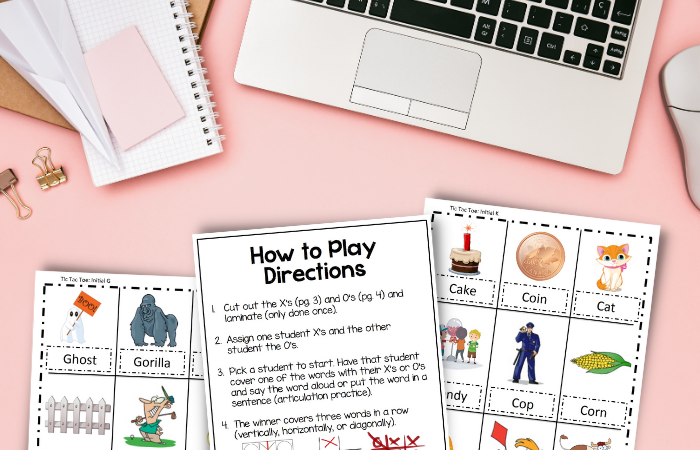
K and G Sound Articulation Techniques
We’ll focus on effective speech therapy techniques that aid in the correct articulation of K and G sounds. Our approach is segmented into understanding tongue placement, engaging in activities to enhance back sound articulation, and utilizing the minimal pairs approach to distinguish between target sounds.
First, let’s review some basics.
Speech Sound Fundamentals
Understanding and working with speech sound production is critical in speech therapy. Key components we attend to are:
- Tongue Placement : Crucial for accurate articulation. For example, for back of the mouth sounds, the back of the tongue rises towards the soft palate.
- Back of the Tongue : This is important for producing sounds like “k” and “g”, which are formed at the back of the mouth .
- Soft Palate : The soft part at the back of the roof of the mouth must be manipulated correctly for certain sounds.
- Vocal Folds : We ensure they function properly for voiced sounds.
We can use tools such as a tongue depressor to facilitate correct tongue placement and exercises that help strengthen the muscles involved in speech.
Tongue Positioning for K and G Sounds
Proper tongue placement is crucial for the correct production of K and G sounds, which are back sounds. For the K sound , the back of the tongue elevates to touch the soft palate, creating a burst of air when released. For the G sound , this placement is similar, but the vocal cords vibrate.
- Raise back of the tongue to the soft palate.
- Create tension before releasing a burst of air.
- Ensure vocal cord vibration for G sound.
Activities for Back Sound Articulation
Speech therapy activities geared towards K and G sounds involve exercises that encourage the correct placement of the tongue for back of the mouth sound articulation.
- Articulation Bundle : A sequence of targeted exercises that focus on sound production.
- Mirror Exercises : Practicing in front of a mirror helps visually confirm tongue placement.
- Blowing Activities : Use activities like blowing bubbles to strengthen muscles necessary for the burst of air required in these sounds.

Minimal Pairs Approach
The minimal pairs approach is a technique that contrasts words differing by only one sound to refine articulation. This method helps individuals distinguish between similar-sounding words, enforcing the correct placement and production of K and G sounds.
- “Come” vs. “Gum”
- “Card” vs. “Guard”
- “Back” vs. “Bag”
Using these pairs in practice drills aids in reinforcing the relative tongue placement and sound articulation for each word.
Specific Techniques for K and G Sounds
When addressing the pronunciation of K and G sounds, it’s crucial to incorporate techniques that engage multiple senses to solidify learning. We’ll explore tactile and kinesthetic strategies as well as methods for enhancing auditory discrimination.
Tactile and Kinesthetic Methods
Tactile and kinesthetic approaches involve physical touch and movement to teach the correct placement and motion for the K and G sounds, which are back sounds. Here are specific strategies:
- Place a finger on the throat : Children feel the vibration of their own voices, discerning between voiced (G sounds) and voiceless pairs of sounds (K sounds).
- Use a mirror : Watching their own tongues can help children understand where the back of the tongue needs to raise to make the K and G sounds.
- Quick movement exercises : Guide children to move their tongues quickly to the correct position, reinforcing the muscle memory required to produce these specific sounds.
Auditory Discrimination for K and G Sounds
Auditory discrimination is crucial for distinguishing between similar sounding phonemes. For K and G sounds, which are front sounds, we can employ the following activities:
- Minimal Pairs : Introduce pairs of words that only differ in the K or G sound (like “cold” and “gold”) to sharpen listening skills.
- Phoneme Isolation : Practice saying words that contain the target sounds, emphasizing the K or G sound so

K & G Resources and Activities
Below you will find a comprehensive list of over 50 ‘K’ and ‘G’ Sound Articulation Activities and Resources!
K & G Initial Sounds
- Initial g and k words speech “fishing” homework freebie by Saidi Marshal is a set of homework sheets with 12 words per page. This is a fun way to practice K and G at the word level!
- FREE Initial K & G Articulation Sound-Loaded Sentences Worksheet by the Speech Spot Creations is a speech therapy worksheet that has target words that start with K and G. Start practicing your students phonological process with this highly rated freebie!
- ARTICULATION CARDS Students can color & keep: Initial K & G FREE! By The Beachy Therapist is a resource with single words and a letter name on a card for students to practice their articulation skills with initial K & G!
BONUS: Our shop store has some amazing articulation bundles! Grab this bundle of over 20 sound decks of cards (Initial, Medial and Final K & G included) for $14. We love sending these home for students to color as homework, then using the deck of cards to play a ton of different articulation games in their speech therapy session. Or have them play those games with family at home!
K & G Final Position
- English & Spanish Articulation K & G Sound Spring Printable for Speech Therapy by Bilingial SLP LLC is a fun spring themed printable to practice final K & G. We recommend this resource for your elementary students.
- Speech Therapy: Final /k/ and /g/ words “fishing” homework by Saidi Marshall is a great resource to have students practice k and g sounds at the end of the word.
- Frog and Pond Speech Therapy Game with Final G Articulation Cards by Speech Sprouts is an engaging final g drilling activity that students love!
Activities with Visual Cues
- Speech Sound Cue Cards – FREEBIE by Lauren Walters is a great resource to have that reminds children with visual cues what theirs mouth should look like as they say a letter sound.
- Final Consonant Deletion: Boat Theme by Speech With Miss Chelsea is an engaging articulation game with the sounds K & G included. Students are given multiple visual cues such as they boat and sentence strips as they practice K & G sounds and build in complexity level.
- Articulation and Speech Sounds visual support BUNDLE (FREE) by Free Speech Goodies is a pack of 11 pages with visual cues on how to pronounce multiple sounds including K and G.
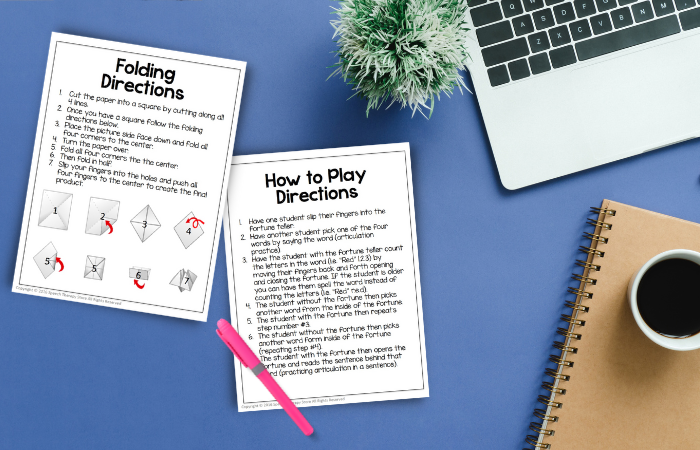
Tactile Activities
- Shape and Say Articulation: Winter Theme Free by Miss Gardenia’s Speech Room is an engaging activity that has students build pictures with shape tiles as they practice their language skills. This activity includes lots of letter sounds including K & G!
- Counting Bears Early Sounds Articulation Mats FREEBIE by Panda Speech is a bundle with multiple sounds that has students practice articulation as they cover mats with counting bears. This is a highly rated hands on activity!
- Dough Articulation: K, G, F, S by Jenna Rayburn Kirk is an activity that younger elementary students love! Print out these mats with the name of the letter K & G and have students use playdough or clay as they practice articulation. We also recommend having students make a play dough ball to build into the pictures on the mats starting with that target sound.
- Magnet Tiles Speech FREE Sample for /k/ and /g/: Articulation Toy Companion by Panda Speech is a favorite hands on activity! Students use magna-tile blocks to build letters and objects with their target sounds and words.
FOR YOU! We love hands on games, so we created a bundle of articulation fortune teller oragamis for students to practice their articulation skills! My students have loved cutting and folding these and then moving their hands around as they practice their target sounds. K & G are included in this bundle, but there are more than 20 sounds! Scroll to the bottom for a free sample of the origami fortune tellers for K and G!
Articulation Games
- ARTICULATION WHEELS: K, G, T, & D FREE! By The Beachy Therapist is such a fun and easy to play game to practice K & G! This is a low prep activity for many different years of age students!
- Go Gumballs Game! Articulation G Initial, Medial and Final! By Now We’re Talkin is a highly rated articulation game for younger elementary students that has a cute, gum ball themed gameboards!
- Ugly Sweater Laundry – Articulation Game by The Urban SLP is a fun articulation game that has students laughing and engaged.
PRO TIP! We love original and creative articulation games, but there is also something to be said about the classics! At our Speech Therapy Store Shop , you will find articulation bundles to go with classic games such as our Articulation Apple to Apple Game , Articulation Connect Four , and Articulation Bingo! Check them out!
Articulation Cards
- HAM Articulation by Speech Me Maybe is a great articulation game with over 72 articulation cards to practice with! This deck focuses on K and G.
- Monkey Match Articulation – k & g by SLPfromCLE is a highly rated articulation cards game that engages students with silly monkeys and written symbols.
- Animal Photo Articulation Flashcards by Busy Miss Lizzy Speech is a set of flashcards for K and G articulation with engaging animal photos on them!
SLPS LOVE IT! Our articulation Go Fish Deck Bundle is a favorite! This deck of articulation cards has something for everyone on your caseload!

Interactive Games
- Build a K and G Articulation Sentence Scene No Print Freebie by Beth Sies Creation for SLPs is a fully interactive game that has students build single words into a short sentence! This is great for students who are at sentence level articulation practice!
- Track The Turkey Articulation – K and G (Lite Version) by Thought Bubble Therapist is an engaging game that has students practice Kand G articulation as they track a turkey in a picture search scene.
- Speech Sounds: S, K, G, F, SH, CH, T, D, P, B by Kristen Leer is a great resource for younger elementary students that prompts them to drag and match single words to pictures.
SEE ALSO: 21 Best Reinforcement Games for Speech Therapy
- FREE SAMPLE Silly Sentences K and G Boom Cards™ Speech Therapy Articulation by Pinwheel Speech Source is a great resource that uses silly sentences to practice K and G at sentence level!
- Boom Digital Cards Articulation K,G Sounds by Badger State Speechie is an interactive boom card set to practice high frequency k and g words!
- Back to School K & G Sounds Boom Cards™ – Sticker Book – Articulation by Michelle’s Communication Corner is a highly rated boom card set that is interactive and fun for elementary students!
Minimal Pairs
- Final /k/ and /g/ Minimal Pairs by the Curious SLP is a great resource for speech students with different types of speech sound disorders. Practice final K and G minimal pairs with a visual cue in this freebie!
- Fronting & Backing Minimal Pairs (/k/ /t/ and /g/ /d/) by Rachel’s Speech Goodies is a 5 page set of minimal pairs flashcards that target the phonological process of k and g fronting.
- Articulation: Minimal Pairs K and G, T and D, CH and SH by Miss Gardnia’s Speech Room is a spring and butterfly themed minimal pairs articulation card set.
- /K/ and /G/ Sound Battleship Word List by Savvy Speech is a complete K and G wordlist that prompts a battle ship game.
- Initial K and G Word List FREE for Speech Therapy Practice by Karina Kurlz is a word lists for K and G with clear and engaging pictures.
- Father’s Day Word List: K & G by The Speech Spot Creations is a set of Initial and Final K and G Words with a Father’s Day theme.
BONUS: Visit our blog for an extensive list of articulation word lists and flashcards , as well as articulation freebies! Here are the highly rated K Word Blog Posts!

Younger Students
- K and G Speech Sound Articulation Homework by Speech Language Lady is a K and G homework bundle created for younger elementary students!
- K and G Fall Trees Printable Articulation Activity Speech Therapy FREEBIE by Pinwheel Speech Resources is a hands on activity for younger students that has them color or dot leaves as they practice their articulation target words.
- No Prep K & G Articulation Fronting Game Boards by Britney Adams – SLP is a fun fall themed game boards for younger students to play on and practice the K and G sounds.
Sentences and Conversational Level
- Encanto Articulation K and G by Jacelyn Kieffner is an older elementary favorite! Students use the movie Encanto to practice K and G articulation at sentence level.
- Build a K and G Articulation Sentence Scene No Print Freebie by Beth Sies Creation for SLPS is a highly rated free resource to practice building sentences with K and G articulation.
- G Flashcards and K Flashcards at sentence/convo level by Speech Therapy Store are a great way to practice articulation at word/phrase/sentence level. Use the flashcards to practice the WH- Questions for conversational level articulation practice too!
High School Students
- Articulation Tower K/G Edition by Speech with Sharon is an engaging game similar to jenga that is great for older students to practice their K and G articulation in a fun way.
- Fry Words Articulation Card Deck- VELARS (Freebie!) by Voices Ablaze is a great resource that helps incorporate more articulation words into literacy sessions for high school students.
- At Home Word Lists for Articulation and Phonology for SLPs – Freebie by Natalie Snyders is an organized word list to practice K and G articulation with your older students! Send this home to practice as homework.
Ready to Go Worksheets
- Spring Themed Articulation K & G Sounds Coloring Work Sheets Print & Go! By Sparkly Speech Girl are no prep, print and go coloring worksheets to practice K and G with your speech students!
- FREEBIE! Valentine’s Day No Prep /K/ & /G/ Articulation by Speachin -n -teachin are fun valentines themed worksheets to practice K and G.
- FREEBIE Articulation Bones – initial /k/ and initial /g/ by a Spoonful of Speech is a no prep set of worksheets for you to use in your therapy room to practice K and G!
SEE ALSO: Free Articulation Games for Speech Therapy
Picture scenes.
- K & G Summer Articulation Folding Surprise Craft by Jeannie’s Speech room is a highly rated craft that opens into a picture scene for students to practice K and G articulation. This is great to send home as homework as well!
- FREE No Print Final Consonant Deletion Picture Scenes for Speech Therapy by Teach Speech 365 is a no print picture scene for your students to practice lots of articulation words including K and G!
- Christmas Search and Find Articulation Homework by Old Speech School is a highly rated free resource! Students search, find and color the target K and G articulation words in a picture scene.
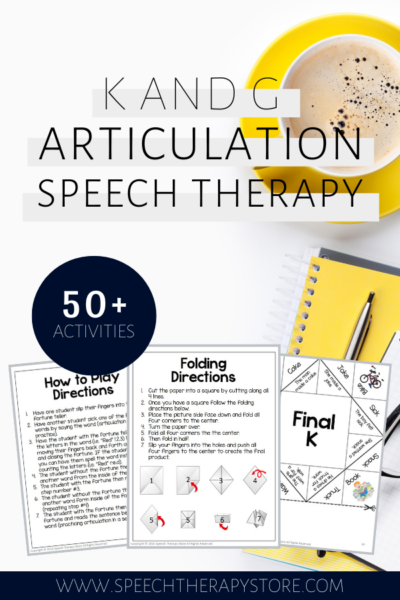
Seasonal Activities
- Free Thanksgiving Baking Articulation Activity (K & G Sounds) by Lil Mae’s Speech is a great set of boom cards with a Fall and Thanksgiving theme!
- Spring Freebie: Articulation /k/ and /g/ by Tale of Two Speechies is a bundle of Spring themed K and G articulation worksheets. This is highly rated!
- Initial /K and G/ Fall Leaves – Articulation Craft FREEBIE by Let’s Get Speechie
Books and Short Stories
- Goodnight Moon by Margaret Wise Brown is perfect for articulation therapy goals on your caseload. The repetitive text with the “g” sounds helps children with speech disorders to anticipate what might come next in the story.
- Articulation K and G: Pictured Silly Stories & Word Lists by Speech2u is a highly rated game that uses K and G silly words to make K and G short and silly sentences!
- G Sound Mini Articulation Activity Book Initial Medial Final Words and Phrases by Pep Talk is an engaging mini book to build with your students to practice the G sound.
For You! Grab our Articulation Reading Passages to practice your articulation goals with your students! This is a bundle of 266 reading passages with 6 stories per sound, and 20 articulation words per passage.
SEE ALSO: 279+ Free Speech Therapy Digital Materials
Reinforcement Games
- Free Sample! /k/ and /g/ Articulation Coloring pages by Easy Peasy Lemon Speechie is a great reinforcement game with high instances of hitting the target sound.
- K & G Articulation Dots FREEBIE! By Linden Speech is a great worksheet that is engaging and reinforcing for students practicing their K and G articulation.
- Hugs and Kisses: Articulation K and G by a Speechie World is a fun and silly game that students love to play! It has one game board and 2 mats.
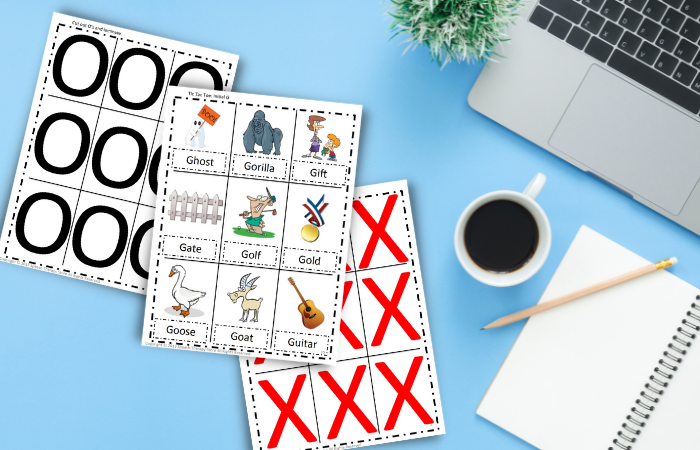
We hope this list of resources to use when practicing K and G articulation is inspirational and helpful for you! There are so many ways to teach K and G, and making the speech therapy session engaging and fun for our students is a high priority!
To help make your sessions fun, but also easy for you to plan, we compiled this bundle of a K and G preview of some of our most popular articulation games! Enter your info below to grab a preview of our Articulation Fortune Tellers and Articulation Tic Tac Toe for the K and G sounds. Find more of our Articulation Game Bundles on our Speech Therapy Store Shop!
<< FILL OUT THE FORM BELOW TO DOWNLOAD A MINI BUNDLE OF K & G ARTICULATION ACTIVITIES! >>
Grab your mini bundle of k and g articulation activities, frequently asked questions.
In addressing these frequently asked questions, we aim to provide specific, evidence-based answers that will be useful for speech therapists, parents, and educators involved in helping children practice and improve their articulation of K and G sounds.
What activities can help children practice K and G sounds in speech therapy?
We often use engaging activities like blowing bubbles to encourage the production of the /k/ sound, as it closely resembles the mouth shape required to say “k.” For the /g/ sound, we might incorporate games involving animals, like gorillas or geese, as they naturally elicit the /g/ sound in a fun context.
How does using minimal pairs in therapy assist with correcting K and G sound errors?
Using minimal pairs, such as “coat” and “goat,” assists in enhancing phonological awareness. We find that this contrastive approach helps children discern the difference between sounds, thereby improving their articulation accuracy for K and G.
What are some age-appropriate K and G speech activities for preschoolers?
We use play-based activities such as “kitchen” stations for the /k/ sound or “garden” themes for the /g/ sound. These relevant, enjoyable activities help preschoolers practice the sounds without the drills feeling like work.
How effective are loaded sentences in the remediation of K and G sounds?
Loaded sentences, which are packed with target sounds, have proven very effective in our work. This repetitive and contextual practice encourages the child to use K and G sounds in a sentence-level format, fostering generalization to natural speech.
What types of ‘Would You Rather’ questions could be used to reinforce K and G sounds in therapy sessions?
We may use questions such as “Would you rather have a pet kitten or a pet kangaroo?” to practice the /k/ sound. For the /g/ sound, we might ask, “Would you rather grow grapes or play a game?” These choices invoke more natural speech and frequently repeat the targeted sounds.
At what age should a child typically be able to pronounce K and G sounds correctly?
Children typically master the K and G sounds by the age of three to four years. However, we observe variations in development, and we emphasize the value of early intervention if a child is showing signs of difficulty with these sounds.

Want Even More K and G Speech Therapy Activities?
- Free SLP Planner [Updated Yearly]
- 917+ Best Free Boom Cards for Speech Therapy
- 31 Best Wordless Videos to Teach Problem Solving
- 133+ Categories List for Speech Therapy
- The Best Handout for Phonological Processing Disorder Therapy
Want the Best of the Bests?
Be sure to check out our most popular posts below!
- 21 Best Reinforcement Games for Speech Therapy / Teletherapy
- Best IEP Resources
- 71+ Free Social Problem-Solving Scenarios
- 430+ Free Multisyllabic Words List Activity Bundle
- 432+ Free Measurable IEP Goals and Objectives Bank
- 279+ Free Speech Therapy Digital Materials
- 179+ Free Speech Therapy Wh-Questions Printable
- WV App Login
- Site Search
- Report Templates
- Speech Helpers
- SLP Resources
- Top 10 Tips
- Getting an Eval
- Certified SLP
- How to Say the R Sound
- 0-18 Months
- 18-36 Months
- 18-30 Months
- 30-36 Months
- 10-11 Years
Articulation
- Cleft Palate
- Phonological
- Dysphagia Causes
- Dysphagia Treatment
Targeted Word Lists for Speech Therapy Practice
The speech therapy word lists are perfect for anyone who needs practice with speech and language concepts . For any type of practice...
...you need words to get started .
Now I don't know about you, but when I need to think of targeted words to use...
...I suffer from spontaneous memory loss , or SML.
It's more common than you might think ;)
This page has words for anyone to practice articulation, apraxia, language, phonology, or stuttering principles . They will help children and adults be successful meeting their goals.
Buy Flashcards for All Articulation Words for $69.99

Explore Our Goal Reaching, Client Centered Products

Each list of articulation sounds contains words with the target sound in the beginning, middle, and end position, including blends when applicable, as well as words that...
- are common and functional (words we use all day...everyday)
- are mostly 1 syllable (multi-syllabic words are more difficult)
- have a phonemic context that don't interfere with production of the target sound (most words)
If "R" is the problem sound using the word "Rope" makes saying the "R" sound harder because the "O" sound is considered a round vowel.
A round vowel is one where you round your lips to say it. Go ahead...try it by saying "O" as in "boat". You rounded your lips didn't you? I thought you might.
Children who have difficulty with the "R" sound tend to say the "W" sound...they say "Wabbit" instead of "Rabbit".
The "W" sound is considered a rounded sound too. Try saying the "W" sound without rounding your lips...you can't because that is how the sound is made.
So by pairing the "R" sound with the "O" sound like in the word "Rope", this makes the word extra difficult for a child who has a problem saying the "R" sound because the "O" that follows the "R" will naturally make them want to round there lips.
SEE ALSO: The Best Free App for Speech Therapy

Social Language
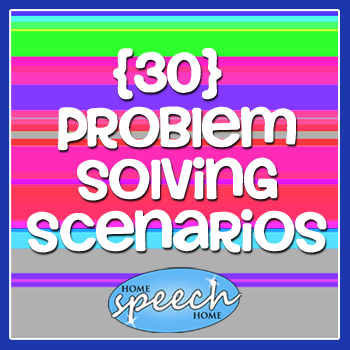
SEE ALSO: The Best Books for Speech Therapy Practice

Do you have a request for a word list we don't have?
Please contact us and we'll get it put on right away.
Freebies, Activities, and Specials, Oh My! Sign up for Terrific Therapy Activity Emails
See Past Email Examples
Your information is 100% private & never shared .

Hi! We're Luke and Hollie.
We are both MS CCC-SLPs and fell in love while studying for our degrees. Since then we have done everything together - graduated, worked, and started a family. We spend most of our time with our family and the rest making this site for you.

Top Free Resources

Word Vault Essential

# 1 Chronological Age Calculator

Popular Materials
All in one printable flashcards.

Multiple Meaning Word Mega Pack

Complete Articulation Word Search

New! 111 Articulation Stories

Teaching the Sound Books

Multi-Syllabic Words Flashcards

Apps to Save You Time & Help Your Clients
Articulation therapy + pirate adventures = awesomeness.

This App Will Get Your Kids Talking

Image Credits
Copyright © 2010 –
HomeSpeechHome.com | All Rights Reserved

This website contains affiliate links, meaning if you buy something from them we may make some money (at no cost to you). By using our affiliate links, you are helping to support our site which is a U.S.-based, family-run small business :)
Speech Writing
Speech Examples
20+ Outstanding Speech Examples for Your Help
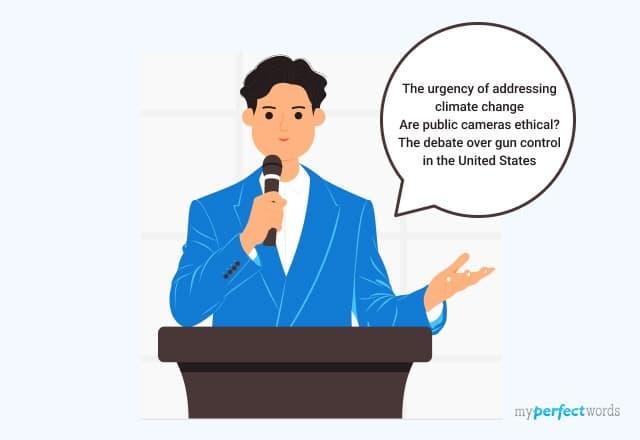
People also read
The 10 Key Steps for Perfect Speech Writing
Understanding the Speech Format - Detailed Guide & Examples
How to Start A Speech - 13 Interesting Ideas & Examples
Common Types of Speeches that Every Speechwriter Should Know
Good Impromptu Speech Topics for Students
Entertaining Speech Topics for Your Next Debate
How to Write a Special Occasion Speech: Types, Tips, and Examples
Introduction Speech - A Step-by-Step Guide & Examples
How to Write the Best Acceptance Speech for Your Audience?
Presentation Speech - An Ultimate Writing Guide
Commemorative Speech - Writing Guide, Outline & Examples
Farewell Speech - Writing Tips & Examples
How to Write an Extemporaneous Speech? A Step-by-Step Guide
Crafting the Perfect Graduation Speech: A Guide with Examples
Public speaking can be daunting for students. They often struggle to start, engage the audience, and be memorable. It's a fear of forgetting words or losing the audience's interest.
This leads to anxiety and self-doubt. Students wonder, "Am I boring them? Will they remember what I say? How can I make my speech better?"
The solution lies in speech examples. In this guide, we'll explore these examples to help students create captivating and memorable speeches with confidence.
So, keep reading to find helpful examples!
- 1. Speech Examples
- 2. Tips to Write a Good Speech
Speech Examples
Talking in front of a bunch of audiences is not as easy as it seems. But, if you have some good content to deliver or share with the audience, the confidence comes naturally.
Before you start writing your speech, it is a good idea that you go through some good speech samples. The samples will help to learn how to start the speech and put information into a proper structure.
Speech Examples for Students
Speech writing is a huge part of academic life. These types of writing help enhance the creative writing skills of students.
Here is an amazing farewell speech sample for students to learn how to write an amazing speech that will captivate the audience.
Below, you will find other downloadable PDF samples.
Speech Examples for Students
Every school and college has a student council. And every year, students elect themselves to be a part of the student council. It is mandatory to impress the student audience to get their votes. And for that, the candidate has to give an impressive speech.
Here are some speech examples pdf for students.
Speech Examples For Public Speaking
Speech Examples About Yourself
Speech Examples Short
Speech Examples For College Students
Speech For Student Council
Speech Examples Introduction
Speech Example For School
Persuasive Speech Examples
The main purpose of a speech is to persuade the audience or convince them of what you say. And when it comes to persuasive speech , the sole purpose of speech becomes more specific.
Persuasive Speech Example
Informative Speech Examples
Informative speeches are intended to inform the audience. These types of speeches are designed to provide a detailed description of the chosen topic.
Below we have provided samples of informative speech for you.
Informative Speech Example
Informative Speech Sample
Entertainment Speech Examples
Entertainment speeches are meant to entertain the audience. These types of speeches are funny, as well as interesting. The given speech samples will help you in writing an entertaining speech.
Entertainment Speech Example
Entertainment Speech Sample
Argumentative Speech Examples
Making a strong argument that is capable of convincing others is always difficult. And, when it comes to making a claim in an argumentative speech, it becomes more difficult.
Check out the argumentative speech sample that demonstrates explicitly how an argumentative speech needs to be written.
Argumentative Speech Example
Demonstration Speech Examples
The demonstrative speeches are intended to demonstrate or describe the speech topic in depth. Get inspired by the demonstrative speech sample given below and write a captivating demonstrative speech.
Demonstration Speech Example
Demonstration Speech Sample
Motivational Speech Examples
Motivational speeches are designed to motivate the audience to do something. Read out the sample motivational speech given below and learn the art of motivational speech writing.
Impromptu Speech Examples
Impromptu speech writing makes you nervous as you are not good at planning and organization?
Check out the sample impromptu speech and learn to make bullet points of your thoughts and plan your speech properly.
Graduation Speech Examples
Are you graduating soon and need to write a graduation farewell speech?
Below is a sample graduation speech for your help.
Wedding Speech Examples
“My best friend’s wedding is next week, and I’m the maid of honor. She asked me to give the maid of honor speech, but I’m not good at expressing emotions. I’m really stressed. I don’t know what to do.”
If you are one of these kinds of people who feel the same way, this sample is for you. Read the example given below and take help from it to write a special maid of honor speech.
Best Man Speech Examples
Father of The Bride Speech Example
Speech Essay Example
A speech essay is a type of essay that you write before writing a proper speech. It helps in organizing thoughts and information.
Here is a sample of speech essays for you to understand the difference between speech format and speech essay format.
Tips to Write a Good Speech
Reading some famous and incredible sample speeches before writing your own speech is really a good idea. The other way to write an impressive speech is to follow the basic tips given by professional writers.
- Audience Analysis: Understand your audience's interests, knowledge, and expectations. Tailor your speech to resonate with them.
- Clear Purpose: Define a clear and concise purpose for your speech. Ensure your audience knows what to expect right from the beginning.
- Engaging Opening: Start with a captivating hook – a story, question, quote, or surprising fact to grab your audience's attention.
- Main Message: Identify and convey your main message or thesis throughout your speech.
- Logical Structure: Organize your speech with a clear structure, including an introduction, body, and conclusion.
- Transitions: Use smooth transitions to guide your audience through different parts of your speech.
- Conversational Tone: Use simple, conversational language to make your speech accessible to everyone.
- Timing: Respect the allocated time and write the speech accordingly. An overly long or short speech can diminish the audience's engagement.
- Emotional Connection: Use storytelling and relatable examples to evoke emotions and connect with your audience.
- Call to Action (if appropriate): Encourage your audience to take action, change their thinking, or ponder new ideas.
- Practice Natural Pace: Speak at a natural pace, avoiding rushing or speaking too slowly.
So, now you know that effective communication is a powerful tool that allows you to inform, persuade, and inspire your audience. Throughout this blog, we've provided you with numerous examples and invaluable tips to help you craft a compelling speech.
And for those moments when you require a professionally written speech that truly stands out, remember that our team is here to help. We can rescue you from writer's block and deliver an outstanding speech whenever you need it.
With our professional essay writing service , you can be confident in your ability to communicate your message effectively and leave a lasting impact.
So, don't hesitate – place order now and buy speech that will truly captivate your audience.

Write Essay Within 60 Seconds!

Dr. Barbara is a highly experienced writer and author who holds a Ph.D. degree in public health from an Ivy League school. She has worked in the medical field for many years, conducting extensive research on various health topics. Her writing has been featured in several top-tier publications.

Paper Due? Why Suffer? That’s our Job!
Keep reading

Opinion Columnists | Opinion: The “illegal immigrant” speech police…
Share this:.
- Click to share on Facebook (Opens in new window)
- Click to share on Reddit (Opens in new window)
- Click to share on Twitter (Opens in new window)
Digital Replica Edition
- Endorsements
Opinion Columnists
Opinion columnists | opinion: the “illegal immigrant” speech police have come for colorado republicans, should the phrase “illegal immigrant” be allowed on the floor of the colorado house yes, and democrats should know they can’t police speech..

Somebody give the Democratic majority in the Colorado General Assembly a copy of the Bill of Rights, large print if available, and underline the First Amendment with a sharpie.
For the second time this year, they have forgotten they cannot prohibit speech or coerce it from their peers, constituents, or anyone else.
This week, Democrats handed Republicans a memo with words they could no longer use when debating immigration policy (e.g., illegal, alien, invader(s), interloper, squatter) and a list of acceptable replacements (e.g., migrant, applicant, undocumented immigrant, immigrant without authorization). Several members have been castigated for saying that which shall not be said.
While ‘invader(s)’, ‘interloper’, and ‘squatter’ overtly convey disapprobation, ‘alien’ has acquired a negative connotation over the past few decades. I’m old enough to remember Sting’s jaunty refrain “Oh, I’m an alien, I’m a legal alien. I’m an Englishman in New York” in his 1987 hit song. The term is still used in legal documents as is the word ‘illegal.’ Although it means ‘without authorization’ or ‘undocumented,’ it lacks euphemistic charm.
Illegal immigration is not merely a paperwork error but a trespass of law. The majority’s acceptable replacement words, meanwhile, are positive or neutral in order to frame the issue and Democrat’s preferred policies in the best light.
Rather than censure dissent by censoring language, Democrats should use their freedom of speech to explain that most recent immigrants applied for asylum and are here legally awaiting adjudication. Only Congress can reform the asylum program to hinder economic migrants entering under the aegis of the law.
Democrats should share the data showing that immigrants are less likely to commit crime than naturally born citizens and that their presence benefits communities economically and culturally. Costs associated with housing, medical care, and education can be mitigated and Democrat’s legislation attempts to do that.
Opponents of these policies are free to discuss the disproportionate costs borne by lower-income communities, schools, and hospitals, how costs impact government budgets and services for regular programs, the abuse of the asylum program, concerns about incentivizing more border crossings, and the fact that criminals do cross illegally into the U.S. and then commit heinous crimes including rape and murder.
Republicans can argue using whatever words they please, even words others find offensive, with prudence as their only guide (should they choose to listen). Their word choice reflects what they believe to be true.
This week’s banned words memo was not the first time Democrats have tried to seize the commanding heights of language. Earlier this session, they trampled the First Amendment rights of their peers and those testifying against a bill to ease name changes for convicted felons who have changed their gender. Dissenters were forbidden to ‘misgender’ (refer to someone by their biological sex) or to ‘deadname’ (refer to a person’s former name).
Forcing someone who believes sex is biologically determined and immutable to use words they consider inaccurate is a clear violation of free speech. It would be no different if a Republican majority forbade peers or constituents to use preferred pronouns consistent with their view that sex and gender are mutable characteristics. Those repudiated for exercising their rights have sued in federal court. They are likely to prevail given favorable rulings in similar free speech cases.
Government officials cannot coerce or curtail speech. They cannot offer the false choice — utter our words or be silent. If Democrats persist in policing language, minority members should sue. In the meantime, they should exploit the memo’s loophole. As written, the only verboten plural noun is ‘invaders.’
Krista L. Kafer is a weekly Denver Post columnist. Follow her on Twitter: @kristakafer.
Sign up for Sound Off to get a weekly roundup of our columns, editorials and more.
To send a letter to the editor about this article, submit online or check out our guidelines for how to submit by email or mail.
- Report an Error
- Submit a News Tip
More in Opinion Columnists

Opinion Columnists | Opinion: A Biden-Trump rematch is, apparently, the best we can do — for now

Opinion Columnists | Opinion: A memo to Colorado Democrats, your assault weapons ban is unconstitutional and unwarranted

Opinion Columnists | Legislators have a clear choice if they want to protect Colorado’s streams and wetlands

Opinion Columnists | Opinion: Colorado isn’t great at recycling. Producer Responsibility should change that
Log in to comment on videos and join in on the fun.
Watch the live stream of Fox News and full episodes.
Reduce eye strain and focus on the content that matters.

Biden appears to read teleprompter instructions out loud in latest gaffe
President Biden appeared to read the words "four more years, pause" from a TelePrompter during a speech at a trade union conference in Washington, D.C. on Wednesday.
- Copy to clipboard Copy to clipboard
- PRESIDENTIAL PRIMARIES
- Today's news
- Reviews and deals
- Climate change
- 2024 election
- Fall allergies
- Health news
- Mental health
- Sexual health
- Family health
- So mini ways
- Unapologetically
- Buying guides
Entertainment
- How to Watch
- My watchlist
- Stock market
- Biden economy
- Personal finance
- Stocks: most active
- Stocks: gainers
- Stocks: losers
- Trending tickers
- World indices
- US Treasury bonds
- Top mutual funds
- Highest open interest
- Highest implied volatility
- Currency converter
- Basic materials
- Communication services
- Consumer cyclical
- Consumer defensive
- Financial services
- Industrials
- Real estate
- Mutual funds
- Credit cards
- Balance transfer cards
- Cash back cards
- Rewards cards
- Travel cards
- Online checking
- High-yield savings
- Money market
- Home equity loan
- Personal loans
- Student loans
- Options pit
- Fantasy football
- Pro Pick 'Em
- College Pick 'Em
- Fantasy baseball
- Fantasy hockey
- Fantasy basketball
- Download the app
- Daily fantasy
- Scores and schedules
- GameChannel
- World Baseball Classic
- Premier League
- CONCACAF League
- Champions League
- Motorsports
- Horse racing
- Newsletters
New on Yahoo
- Privacy Dashboard
Watch: Biden reads ‘pause’ aloud from teleprompter in latest speech blunder
- Oops! Something went wrong. Please try again later. More content below
Joe Biden has suffered an “Anchorman moment” after he read out a prompt to “pause” on his teleprompter to a baffled audience.
The US president , 81, spoke at a trade union event in Washington, DC on Wednesday, where he read pre-prepared marks to a crowd of several hundred people.
“I see an America where we defend democracy, not diminish it,” he said. “I see an America where we protect freedoms, not take them away.
“I see an economy that grows a lot in the bottom up where the wealthy pay their fair share, so we can have child care, paid leave and so much more, and still reduce the federal deficit and increase economic folks.
After listing his achievements in office, Mr Biden told the audience: “Imagine what we could do next. Four more years.”
He then added: “Pause.”
The direction is thought to have been added by his aides, who had hoped Mr Biden would stop speaking to allow the crowd to chant “four more years” back at him.
I’m Joe Biden ...? President’s ‘Anchorman moment’
The gaffe was compared to a scene from the 2004 comedy film Anchorman, in which a newsreader played by the American actor Will Ferrell accidentally reads out directions to viewers.
Elsewhere in the speech, Mr Biden wrongly claimed he had “cut the national debt”, which has increased from $21.8 trillion in February 2021, when he took office, to $34.7 trillion.
Mr Biden has become known for his frequent gaffes in his public remarks , which have included reference to the “nine wonders of the world”, describing a recent encounter with long-dead former French leader Francois Mitterand, and confusing the presidents of Mexico and Egypt.
In a speech in Florida on Tuesday, Mr Biden mistakenly said that “we can’t be trusted” instead of “he can’t be trusted” in remarks directed at Donald Trump.
Earlier this year, a prosecutor appointed to investigate claims he had illegally stored classified documents in his garage concluded he should not be tried because a jury would find him to be a “well-meaning, elderly man with a poor memory” .
Mr Biden’s aides have defended his mental acuity , describing him as sharp in private meetings and pointing to historic examples of his verbal slip-ups as evidence the recent gaffes have not been caused by his age.
Broaden your horizons with award-winning British journalism. Try The Telegraph free for 3 months with unlimited access to our award-winning website, exclusive app, money-saving offers and more.
Recommended Stories
New bills wr keon coleman makes hilarious first impression with macy's shopping advice and more.
If nothing else, the Bills have a player who can recognize a good deal.
Lionel Messi is picking apart MLS at a ridiculous rate
Messi, after two more goals and an assist Saturday, is averaging 2.5 goal contributions per 90 minutes so far this MLS season.
Will a TikTok ban impact creator economy startups? Not really, founders say
President Joe Biden signed a bill on Wednesday that could ban TikTok — for real this time. “I think two years ago, this would have been devastating,” Karat Financial co-founder and co-CEO Eric Wei told TechCrunch.
Cowboys owner Jerry Jones compared his 2024 NFL Draft strategy to robbing a bank
Dallas Cowboys owner Jerry Jones made an amusing analogy when asked why the team selected three offensive lineman in the 2024 NFL Draft.
NFL Draft: Alabama safety Jaylen Key is 'Mr. Irrelevant' as Jets take him with final pick
Alabama safety Jaylen Key was selected with the 257th and final pick of the 2024 NFL Draft.
TikTok faces a ban in the US, Tesla profits drop and healthcare data leaks
TikTok's fate in the U.S. looks uncertain after President Joe Biden signed a bill that included a deadline for ByteDance, TikTok's parent company, to divest itself of TikTok within nine months or face a ban on distributing it in the U.S. Ivan writes about how the impact of TikTok bans in other countries could signal what’s to come stateside. California drones grounded: In more Amazon news, the tech giant confirmed that it's ending Prime Air drone delivery operations in Lockeford, California.
NFL Draft: Joe Milton III selected by the Patriots, who double up at quarterback
The Patriots took a shot on strong-armed Joe Milton III in the sixth round.
NFL Draft: Brenden Rice, son of Hall of Famer Jerry Rice, picked by Chargers
Brenden Rice played the same position as his legendary father.
NBA playoffs: Sharpshooting Thunder puts Pelicans on verge of elimination with Game 3 win
The Oklahoma City Thunder took a 3–0 series lead over the New Orleans Pelicans with a 106–85 win in Game 3 on Saturday.
Mike Tomlin says Russell Wilson has lead for QB spot but Justin Fields will compete
Mike Tomlin said Russell Wilson is currently the Steelers' QB1.
Google asks court to reject the DOJ’s lawsuit that accuses it of monopolizing ad tech
Google filed a motion on Friday in a Virginia federal court seeking summary judgment for the Department of Justice's antitrust case against it. The DOJ sued Google at the beginning of 2023 for alleged monopolistic practices.
Report: Damian Lillard has strained Achilles, is doubtful for Game 4 of Bucks-Pacers NBA playoff series
Damian Lillard is doubtful to play in Game 4 of the Milwaukee Bucks' first-round NBA playoff series with the Indiana Pacers. Lillard suffered an Achilles injury on a drive to the basket in Game 3.
Kristi Noem says she shot and killed her dog. What to know about the South Dakota governor's recent controversy.
The controversial politician revealed in her new book that she killed her dog.
Deal Dive: Givebutter is turning a profit making tech for nonprofits
Givebutter started in a George Washington University dorm room in 2016 as a software solution to make nonprofit fundraising more transparent and fun. Eight years later, the company is profitable and it just raised $50 million to scale as momentum for nonprofit-focused startups appears to be growing. Friedman told TechCrunch that regardless of the size or scope of the organization he was fundraising for, they all had the same problem: They all used a disjointed mix of one-solution tech software that didn't really make the process better and often came with hidden fees.
Photos: Tornadoes rip through Nebraska and Iowa, destroying homes and causing severe damage
Tornadoes tore through the Midwest this week.
Resumes have changed. Here's what job seekers need to know.
Over the last five years, the workplace has changed, and along with it, the way job seekers should write resumes.
Creators of Sora-powered short explain AI-generated video's strengths and limitations
OpenAI's video generation tool Sora took the AI community by surprise in February with fluid, realistic video that seems miles ahead of competitors. Shy Kids is a digital production team based in Toronto that was picked by OpenAI as one of a few to produce short films essentially for OpenAI promotional purposes, though they were given considerable creative freedom in creating "air head." In an interview with visual effects news outlet fxguide, post-production artist Patrick Cederberg described "actually using Sora" as part of his work. Perhaps the most important takeaway for most is simply this: While OpenAI's post highlighting the shorts lets the reader assume they more or less emerged fully formed from Sora, the reality is that these were professional productions, complete with robust storyboarding, editing, color correction, and post work like rotoscoping and VFX.
A wrestling match over who should control robotaxis is playing out in California
Cities around the country have long been crying out for more control over how autonomous vehicles are deployed on their streets. In California, they might finally get their wish. The bill, which passed the Senate Transportation Committee this week, is one of several laws that have been introduced in California this year dedicated to putting guardrails on the pioneer technology.
NBA Playoffs: Suns' much-hyped season all but over after falling behind 3-0 vs. Timberwolves
Anthony Edwards dropped 36 points in Phoenix.
2024 NFL Draft: Fantasy football winners and losers after Rounds 2 and 3
Scott Pianowski examines the potential fantasy impact of intriguing receivers and running backs taken on Day 2 of the NFL Draft.

How To Use Speech-To-Text On Google Docs
W hether you're on the move or suffering from an unfortunate bout of carpal tunnel, there are plenty of scenarios when simply typing out passages of text on a keyboard just isn't the most feasible option. That's why phones, TVs, and other smart devices have adopted various bits of speech-to-text software, allowing a program to automatically record and transcribe spoken words into written text with the touch of a button. Fortunately, it seems that text editor programs have also joined the speech-to-text wave, including one particularly popular online word processor.
The current iteration of Google Docs includes an optional feature in its suite of tools that adds speech-to-text functionality to the typical document writing process. Known as voice typing, this specialized tool uses built-in software and a compatible device's microphone to allow the user to vocally dictate entire documents' worth of text on Google Docs, proper punctuation and all. It's a feature that's worth trying out for avid users of the program, and it's not too hard to get it working at a moment's notice.
Read more: 5 Forgotten PS3 Features That Are Pure Nostalgia
How To Use Voice Typing In Google Docs
While it isn't possible to leave voice typing enabled at all times in Google Docs, it can be activated on any given document with a few quick steps.
- Open the Google Docs document you want to use voice typing with.
- Ensure that the device you're accessing Google Docs on has a microphone and that is enabled and unmuted.
- At the top of the page, select Tools.
- Click Voice typing from the dropdown menu.
- A small widget box with a microphone icon will appear on the page. Click the microphone icon.
- Your browser may ask if you want to give Google Docs permission to use your device's microphone. If this occurs, select Allow.
- Ensure that the microphone icon has turned red.
- Voice typing is now enabled. Speak aloud and Google Docs will automatically transcribe the audio into written text.
- Once you have finished speaking, click the red microphone icon and ensure that it returns to the gray microphone icon in the widget box. Voice typing is now disabled.
Voice typing can be set to automatically detect and dictate well over 60 distinct languages and a plethora of regional dialects and accents. Similar to keyboard shortcuts , voice typing also recognizes phrases of punctuation and will add the appropriate symbols based on phrases like "Period," "Comma," "Question mark," and more.
Google Docs Has Voice Commands As Well
Speech-to-text is a great way for users to give their fingers a rest and let programs shoulder the weight of typing out text, but some may have concerns that a vocal dictation software like Google Docs' voice typing is relatively limited in what it can do. However, voice typing on Google Docs has a far more robust feature set than simply transcribing audio. In reality, the feature supports a lengthy list of voice commands that give users the power to make all sorts of changes to their documents without even touching the keyboard.
Voice typing is designed to recognize and distinguish specific voice commands from regular spoken words. These commands can range from basic functions like "Copy," "Paste," and "Italicize" to complex actions like "Insert table of contents" or "Create bulleted list." Essentially, voice typing supports vocal shortcuts for just about every basic action one can take while normally editing a document through Google Docs, right down to dictating the exact formatting of the document itself. Generally speaking, the software will recognize whatever editing-related command is given. However, should users have trouble getting the software to do exactly what they want, they can simply request to "See all voice commands" to get a comprehensive list.
For the time being, Google Docs voice typi m,ng can only recognize and carry out English voice commands. Nonetheless, this software stands as quite an important accessibility feature . /,
Read the original article on SlashGear
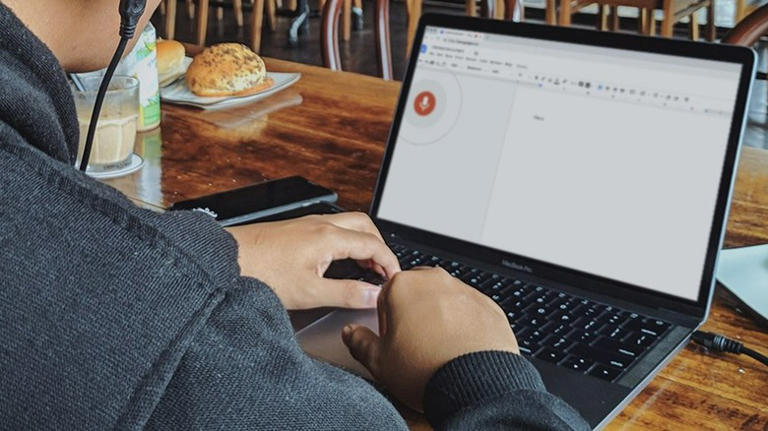

- Liberty University
- Jerry Falwell Library
- Special Collections
- < Previous
Home > ETD > Doctoral > 5483
Doctoral Dissertations and Projects
How to create things with words: identifying the performative speech acts of god’s spoken words in the genesis 1 creation account.
Ivan C. Yu , Liberty University Follow
Rawlings School of Divinity
Doctor of Philosophy in Theology and Apologetics (PhD)
David D. Pettus
Genesis 1, creation, creationism, material creation, functional creation, Trinity, Elohim, logos, yom, day, young earth, Speech Act Theory, J.L. Austin, John Searle, locutionary act, illocutionary act, perlocutionary act, Kevin Vanhoozer, John H. Walton, Ancient Near East, form criticism, comparative studies
Disciplines
Christianity | Religious Thought, Theology and Philosophy of Religion
Recommended Citation
Yu, Ivan C., "How to Create Things with Words: Identifying the Performative Speech Acts of God’s Spoken Words in the Genesis 1 Creation Account" (2024). Doctoral Dissertations and Projects . 5483. https://digitalcommons.liberty.edu/doctoral/5483
Speech Act Theory is a branch of linguistics that explores not only how language is used to convey meaning, but also how it is used to perform actions or functions. In recent decades, it has been applied as a viable hermeneutical tool to aid biblical interpretation and defend the inerrancy of Scripture. Identifying the speech acts of the biblical author or speakers in the biblical narratives can be useful to understand the meaning and intention of the utterances, phrases, and words spoken. In the Genesis 1 creation narrative, God spoke words to create the universe. While adopting a canonical approach to interpretation and a trinitarian reading, this research applied Speech Act Theory to Genesis 1 to identify the locutionary, illocutionary, and perlocutionary acts God performed with His speech on each day of creation. In doing so, it showed how the application of Speech Act Theory to the Genesis 1 creation narrative can be a viable hermeneutical tool to understand that the narrative intended to communicate how God created a universe of material origins instantaneously in a way that is consistent with His character as the Trinitarian God. This research also used Speech Act Theory to critique John H. Walton’s functional view of creation in Genesis 1 and reveal the challenges of his speech act methodology with Ancient Near East comparative studies.
Included in
Christianity Commons , Religious Thought, Theology and Philosophy of Religion Commons
- Collections
- Faculty Expert Gallery
- Theses and Dissertations
- Conferences and Events
- Open Educational Resources (OER)
- Explore Disciplines
Advanced Search
- Notify me via email or RSS .
Faculty Authors
- Submit Research
- Expert Gallery Login
Student Authors
- Undergraduate Submissions
- Graduate Submissions
- Honors Submissions
Home | About | FAQ | My Account | Accessibility Statement
Privacy Copyright

IMAGES
VIDEO
COMMENTS
245+ G Words, Phrases, Sentences, and Reading Passages. As promised here are the words for your unlimited use. If you know others who can use our lists ..... please share this page using our site share buttons. We also offer a free 5 part video series on Teaching the G sound. Explore Our Goal Reaching, Client Centered Products
gecko girl gas goat gorilla gate golf game ghost good gum go guitar goal get glue /g/ gar initial words bage gooey
G Words Speech Therapy. For your unlimited use, I've gone ahead and gathered over 600 g words to work on your student's or child's speech. Word Level: G Words Speech Therapy. One way to practice is to have your child or student practice their target sound at the word level. Below is a list of initial g words, medial g words, and final g ...
A Speech Therapist shares tips on how to teach the G sound. Learn about voice and voiceless pairs. Includes initial G word list, medial G word list, and final G word lists. Activity ideas and speech therapy resource suggestions for the G sound. Games for the G sound. Books for the G sound. Speech and Language at Home.
G Words Speech Therapy Articulation Picture Cards. School SLPs will love these articulation speech sound mouth cards, which target a variety of specific speech sounds, including the g sound! For each speech sound, a mouth visual is provided. Target sounds are provided in initial, medial, and final word positions.
initial g words. /g/ initial words Created by Heather Gehringer, M.S. CCC-SLP in Boardmaker©2010 www.heatherspeechtherapy.com. garbage goldfish garage. Title. Microsoft Word - initial g words.doc. Author.
Wa g on - Drag a wagon around the house and put objects in it, say "wagon" with every object. All G one - Say "all gone" every time you are done with something, i.e., game, food, laundry. Ba g - Put ojects in a bag and say in "bag" as you do so. Hu g - Say "hug" as your child hugs you or his bears.
As a client or a speech-language pathologist, incorporating G words into daily routines and communication can be highly beneficial. Encourage conversation, storytelling, and reading materials that focus on G words to reinforce practice and enhance overall progress. Remember, working on G words in speech therapy is a dynamic and gradual process.
Here are a couple of initial G words lists, 40 free PDF flashcards, and some example sentences that can be used for pronunciation exercises. These resources can be used for articulation lessons with ESL learners and speech therapy for any speakers who have issues making the /g/ sound.
Target the G sound at the isolation level with 3 different activities: Isolation Animation, Pop the Bubbles, and Click the Button! Target G at the syllable level with our virtual flashcards! We have three activities for targeting G at the word level: 1.) Classic flashcards with initial, medial, final, and mixed sets. 2.) Minimal Pair Sliders 3.)
How to Teach G Sound: Articulation Activities, and Word Lists for Effective Speech Therapy. The "g" sound is a voiced velar plosive, which means that it is produced by briefly stopping the airflow from the lungs using the back of the tongue (velar) and then releasing it in a sudden burst (plosive). The vocal cords vibrate during the ...
Initial /g/ sentences ©2019 www.heatherspeechtherapy.com goat goose go game gorilla The _____ likes to eat grass. The _____ walks by the pond.
Improve sentence comprehension, language and reading comprehension, and picture comprehension with 4 activities and over 125 prompts for speech therapy or classrooms! Target comprehending, receptive language, and more.
-g- final words Author: hhanks Created Date: 7/9/2010 2:53:46 PM ...
Practice saying the "g" sound around the house in conversation, read books together and emphasize that sound (both the soft and hard sounds). Soon enough, your child will be "giddy" that he can make the perfect sound of "g". Pronunciation & Lisps Speech Therapy Techniques. Your child should be correctly pronouncing the sound of ...
Free Worksheets. I created these free speech and language worksheets so you can easily download and print them out to use as part of your speech therapy program. Just scroll down the page to view the worksheets by topic. You will find free speech therapy worksheets for articulation, vocabulary , grammar, holiday articulation and language games ...
G Sound in Speech Therapy. The "g" sound is a voiced velar fricative. Also, the "g" sound is made by first pressing the back of the tongue against the velum, or soft palate, and then moving it forward to touch the upper teeth. A g sound can be used at the beginning of a word to represent an action that will happen in the future.
My K Articulation Playing Cards - Outline + Color Printable Deck for Speech Therapy and G Articulation Playing Cards: Outline + Color Deck for Speech Therapy are perfect for some targeted practice and they work with any game you can play with regular cards!. I also have a few products that I like to use with all speech sounds. I like to use my Mini Articulation Cards for Speech Therapy for ...
final g words. Final /g/ words Created by Heather Gehringer, M.S.CCC-SLP in Boardmaker©2011 www.heatherspeechtherapy.com. tag dog hot dog bag plug bug rag jug hug mug rug flag price tag wag pig jog big frog. Title. Microsoft Word - final g words.doc. Author. hgehringer.
A speech-language pathologist often targets k and g words in speech therapy. Many children, especially young children, have a hard time correctly producing k & g. SLPs teach the correct placement for velars and practice the target sound (k,g) in words, short phrases, and at the sentence level.
K & G Initial Sounds. Initial g and k words speech "fishing" homework freebie by Saidi Marshal is a set of homework sheets with 12 words per page. This is a fun way to practice K and G at the word level! FREE Initial K & G Articulation Sound-Loaded Sentences Worksheet by the Speech Spot Creations is a speech therapy worksheet that has target words that start with K and G. Start practicing ...
-g- medial words Author: hhanks Created Date: 7/9/2010 3:31:00 PM ...
Example: If "R" is the problem sound using the word "Rope" makes saying the "R" sound harder because the "O" sound is considered a round vowel. A round vowel is one where you round your lips to say it. Go ahead...try it by saying "O" as in "boat". You rounded your lips didn't you? I thought you might.
Gabby is a girl who likes to go, go, go. Gabby goes to the grocery store. to get green grapes. /g/ initial story. Gabby goes to the pet store to. to get a green gecko. Gabby goes home. to get some rest.
Tips to Write a Good Speech. Reading some famous and incredible sample speeches before writing your own speech is really a good idea. The other way to write an impressive speech is to follow the basic tips given by professional writers. Audience Analysis: Understand your audience's interests, knowledge, and expectations. Tailor your speech to ...
This week, Democrats handed Republicans a memo with words they could no longer use when debating immigration policy (e.g., illegal, alien, invader(s), interloper, squatter) and a list of ...
President Biden appeared to read the words "four more years, pause" from a TelePrompter during a speech at a trade union conference in Washington, D.C. on Wednesday.
Joe Biden has suffered an "Anchorman moment" after he read out a prompt to "pause" on his teleprompter to a baffled audience.. The US president, 81, spoke at a trade union event in Washington, DC on Wednesday, where he read pre-prepared marks to a crowd of several hundred people. "I see an America where we defend democracy, not diminish it," he said.
Speech-to-text is a great way for users to give their fingers a rest and let programs shoulder the weight of typing out text, but some may have concerns that a vocal dictation software like Google ...
Speech Act Theory is a branch of linguistics that explores not only how language is used to convey meaning, but also how it is used to perform actions or functions. In recent decades, it has been applied as a viable hermeneutical tool to aid biblical interpretation and defend the inerrancy of Scripture. Identifying the speech acts of the biblical author or speakers in the biblical narratives ...